The best microphone for streaming, gaming, and podcasting
The best microphone for gaming and streaming makes you sound professional. Not only does the best microphone sound crystal clear, but it's easy to use too—you won't need an audio engineering degree to get the most absolute best from it. Plug it in, turn it on, and you're good to start capturing your beautiful vocals. Easy.
Don't know your XLR from your elbow? Don't worry, I've tested dozens of microphones and picked out the best ones for every situation. Shopping for a microphone online is an exhausting experience. To help, I've recorded test audio samples of my favorite microphones so you can hear the differences and help narrow down your choice.
USB microphones are the go-to option for the vast majority of at-home streaming and podcasting. Audiophiles will want to go down the XLR route because of its sound quality and flexibility; however, good XLR mics are often way more expensive than your typical USB mic. XLRs also require an external audio interface to connect to your PC, like the Focusrite Scarlett Solo, which isn't cheap.
The good news is we've seen a rise in budget microphones under $100 recently. They offer excellent recording quality at a fraction of the cost. The only real downside is that they lack features like mute buttons and gain controls. But when you can pick them up for as little as $40, it can well be worth the sacrifice. Below we've put together a list of the best microphones we've tested for different budgets and uses.
Best microphone for streaming
Hear these microphones for yourself using the Soundcloud embed below.
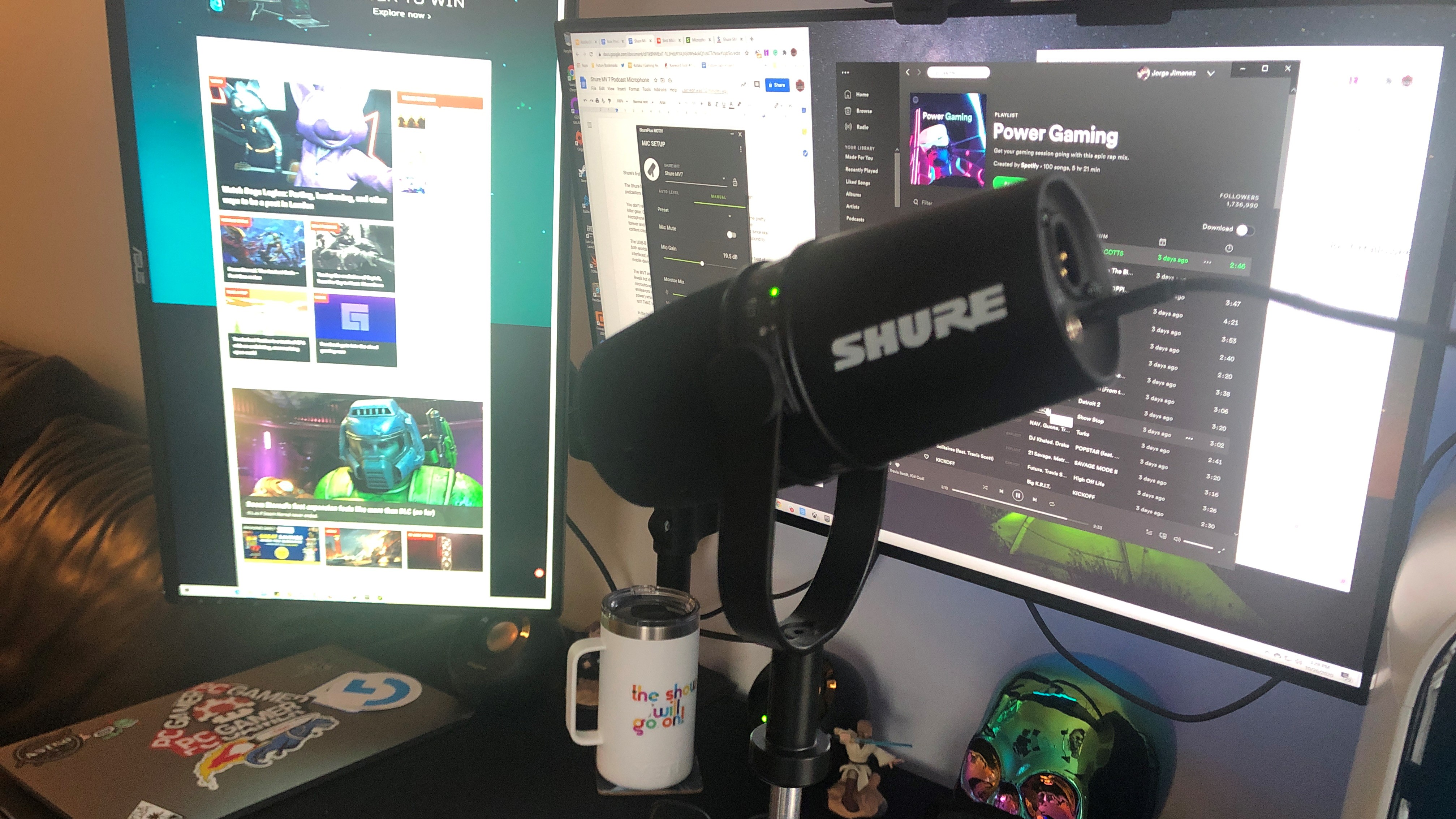
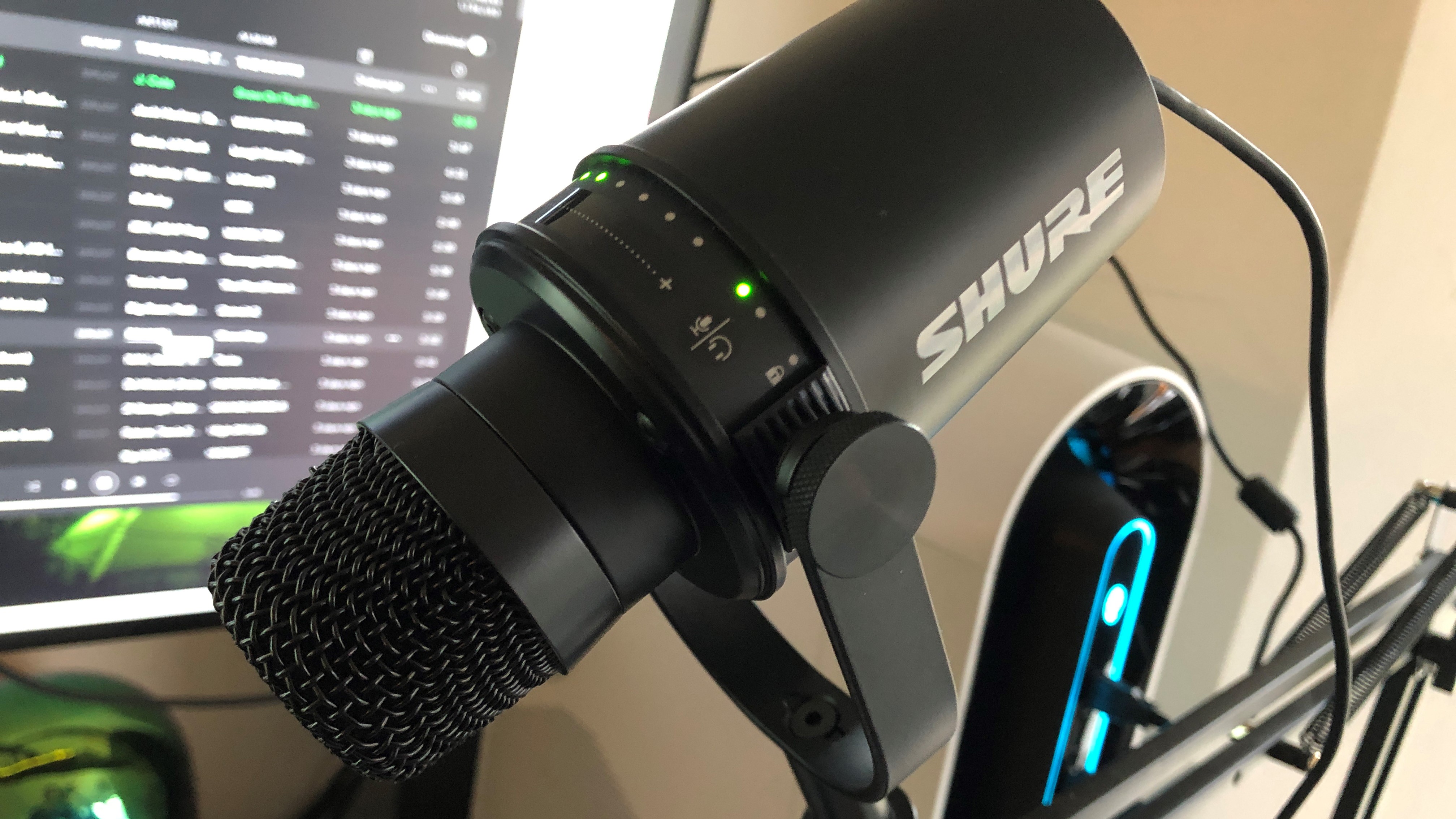
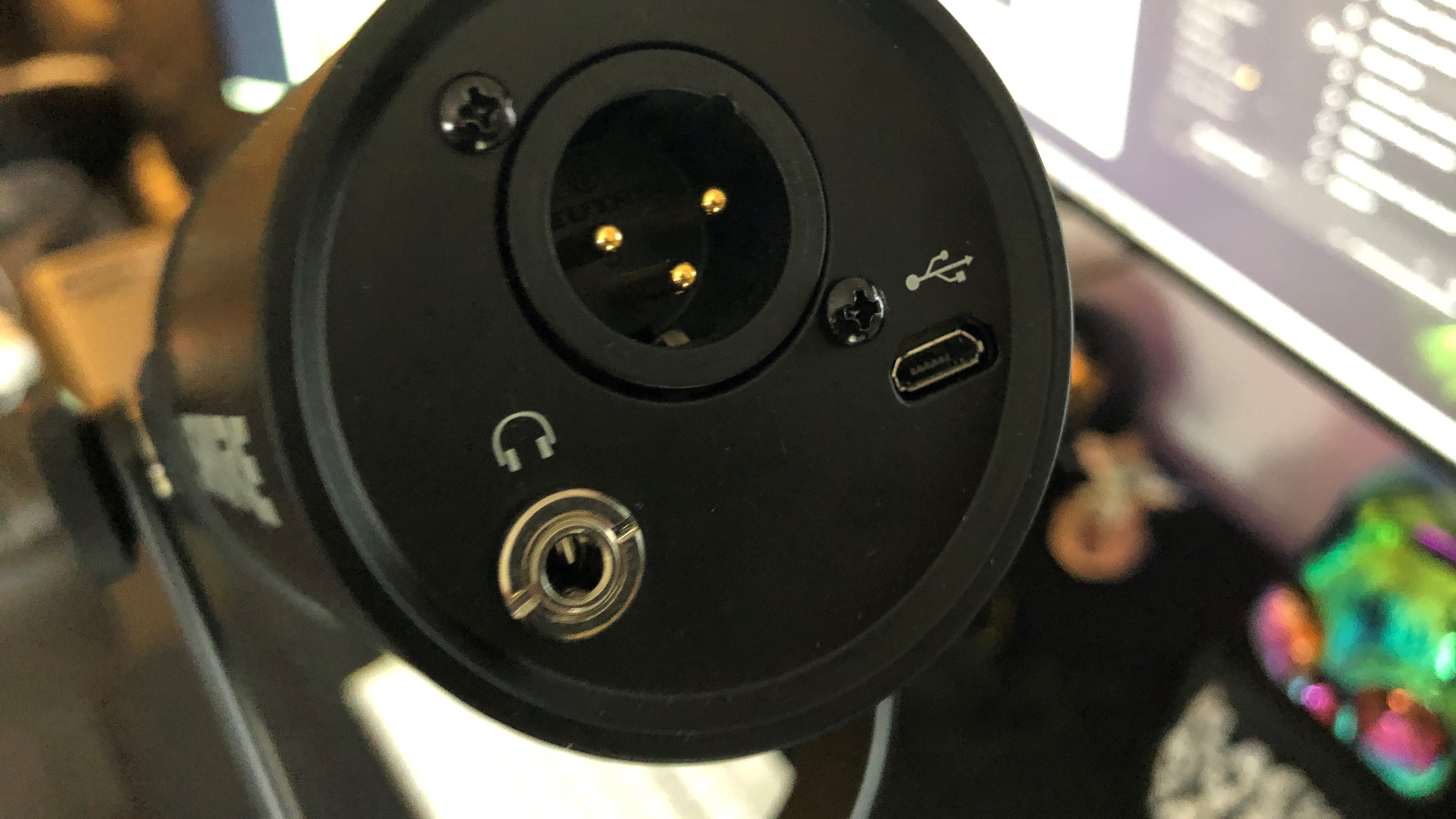
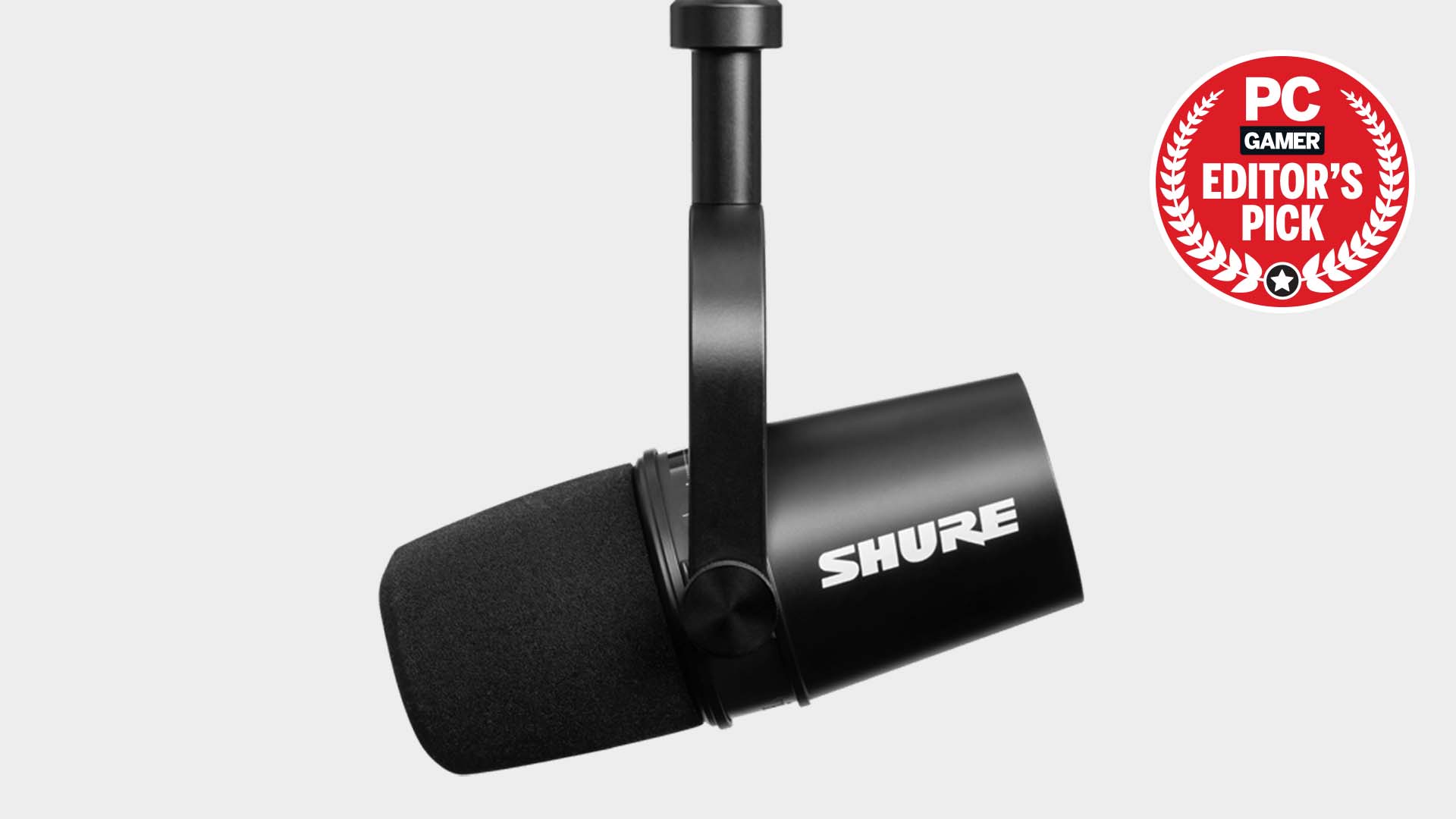
If you're a musician or want your voice to sound the way it's meant to be heard, the MV7 is an easy recommendation. If you don't mind reaching deep into your pocketbook, that is. There are affordable mics on this list, but it is still absolutely true that if you want the best, you will have to pay for it.
You don't really need to be much of a sound person to know Shure makes killer audio gear. Chances are, you've seen some of your favorite musicians rock a Shure microphone on stage or in the studio. Shure has been providing pro-grade microphones for an age, and the MV 7 Podcast microphone is its attempt to bring its high-end sound to content creators.
The USB Type-B Micro/XLR connection will be the big draw for a lot of folks. It gives you the best of both worlds by providing the adaptability of XLR (especially if you use professional audio interfaces) and the versatility of Type-B Micro inputs for recording on the go with laptops and mobile devices.
The Shure MV7 is a great-sounding XLR/USB hybrid microphone that'll give veteran podcasters and streamers a serious upgrade.
Shure's first hybrid XLR/USB microphone manages to provide pro-grade sound with minimal set-up and expertise. While it is more expensive than your average premium mic, its versatility completely justifies the cost. It's hands-down one of the best microphones I've used for recording.
The mic itself does an excellent job of isolating my voice while ignoring the loud hums of my desktop PC, air conditioner, and any other ambient nonsense I have going on in the background. You will notice some pretty loud plosives, so it might be best to invest in a shield to block your breath from the mic, or not having the mic directly in front of you when recording.
The MV7 takes advantage of the ShurePlus Motiv software, which lets you tweak and fine-tune your sound with relative ease. From here, you can mess with things like adding compression to your voice, adjust your EQ, and add a limiter. One of the more understated features is the Auto Level Mode. We've seen similar features in other mics, such as the Elgato Wave 3, which basically keeps you from hitting the red. That's especially useful if your content involves lots of shouting or singing or both. So now you don't have to worry about bursting your viewers' eardrums when a jump scare gets the better of you in Phasmophobia. Also, nice if you're a bit of an audio novice, and your recording area isn't acoustically sound.
The Shure MV7 is a great-sounding XLR/USB hybrid microphone that'll give veteran podcasters and streamers a serious upgrade, especially if you're looking for a microphone that'll plug into a USB audio interface at first and later can be useful in upgrading to an all XLR setup down the line. It's for content creators who want to bring their production values to pro-grade levels but don't want to or can't spend that pro-grade money. $250 for a hybrid USB/XLR microphone isn't that big of an ask when you consider the flexibility of the Shure MV7.
Read our full Shure MV7 Podcast Microphone review.
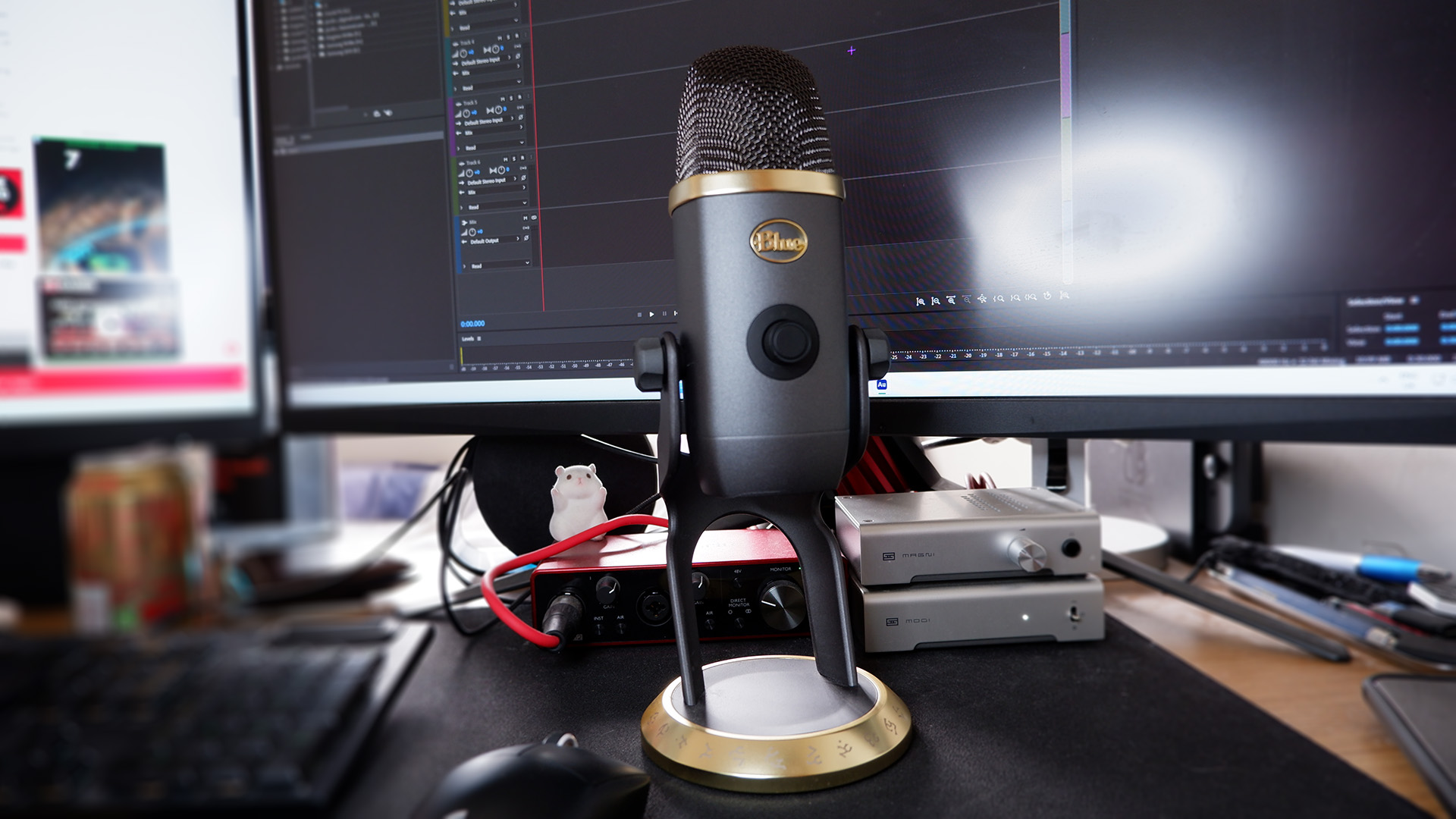
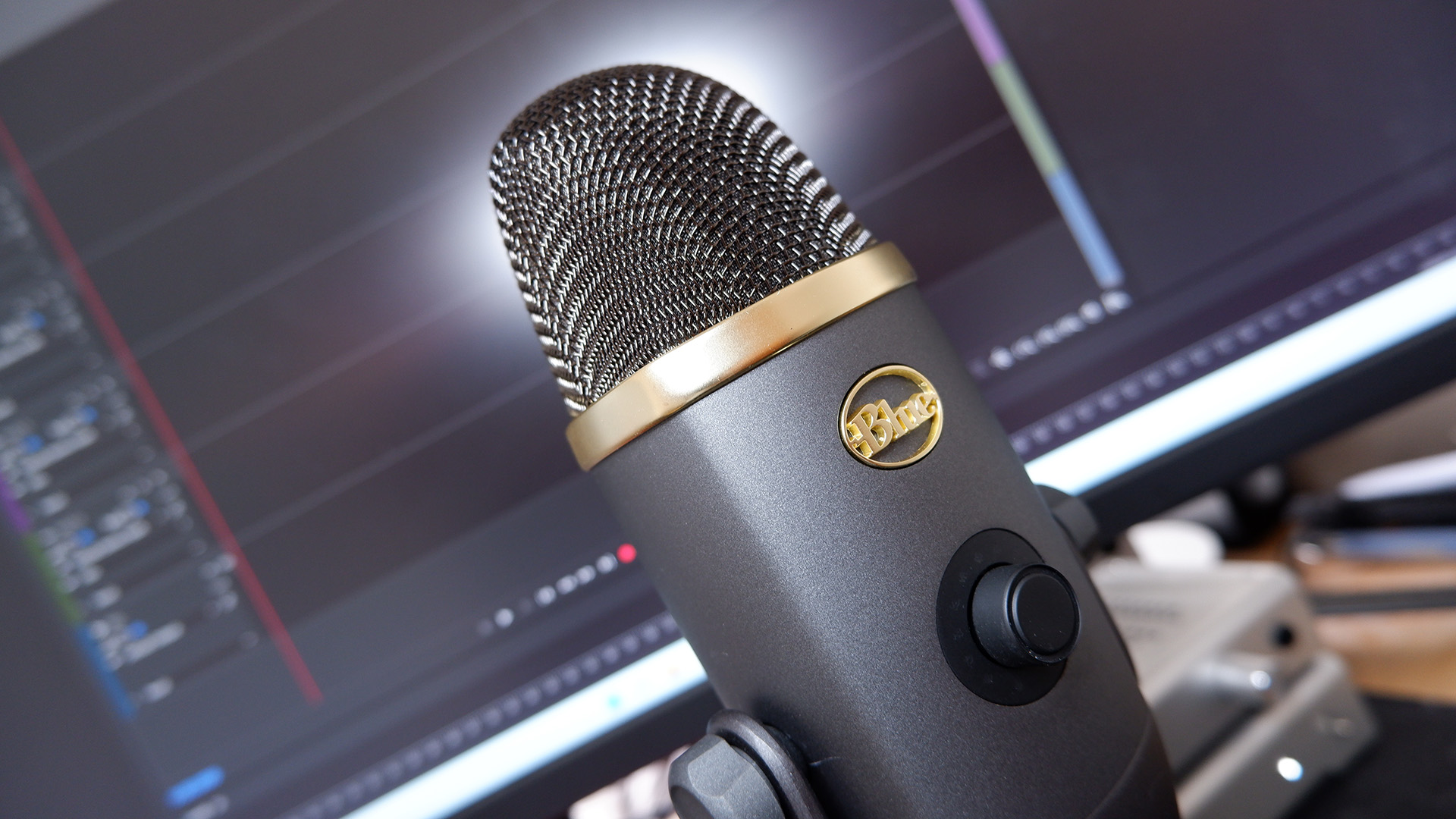
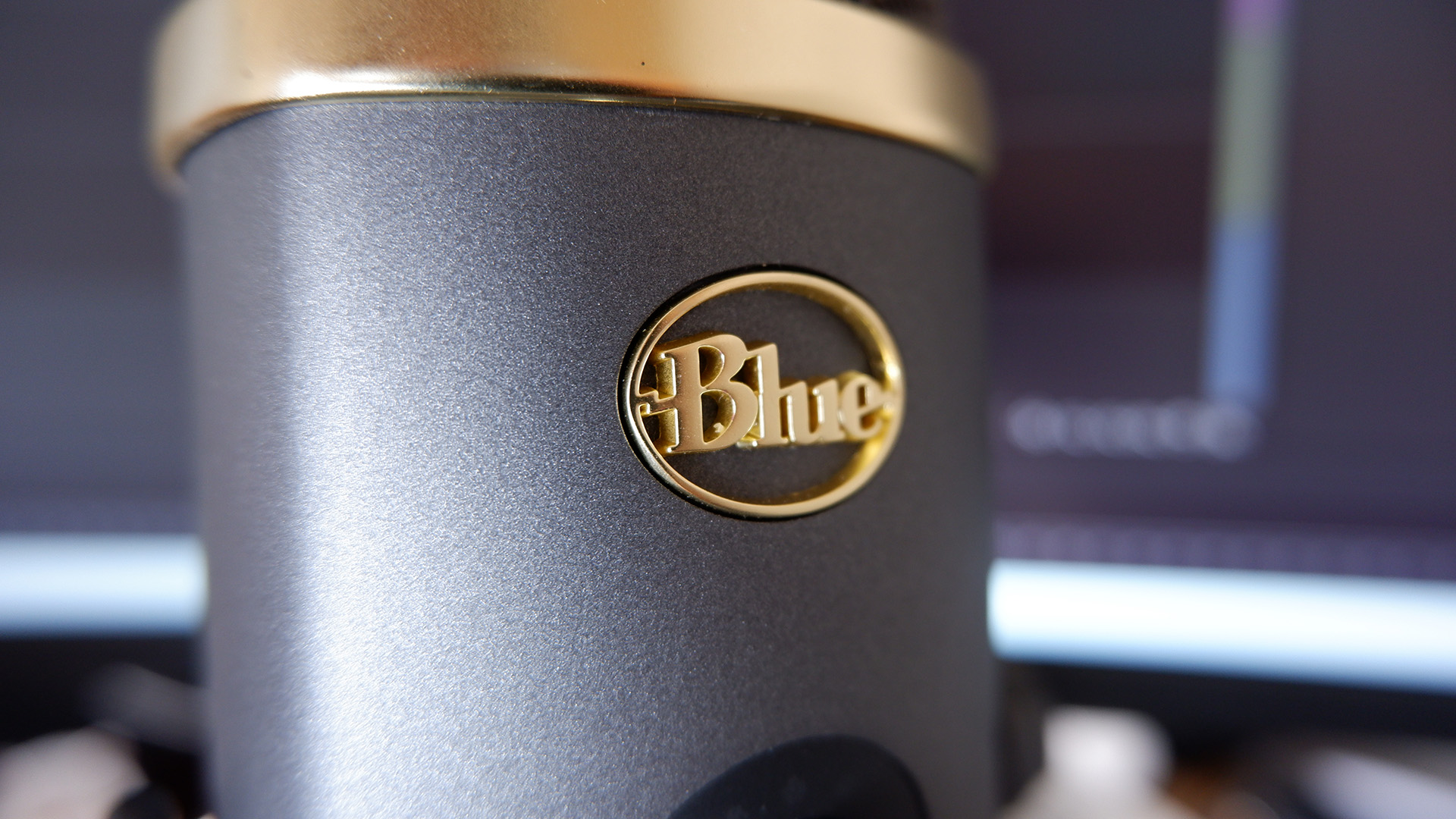
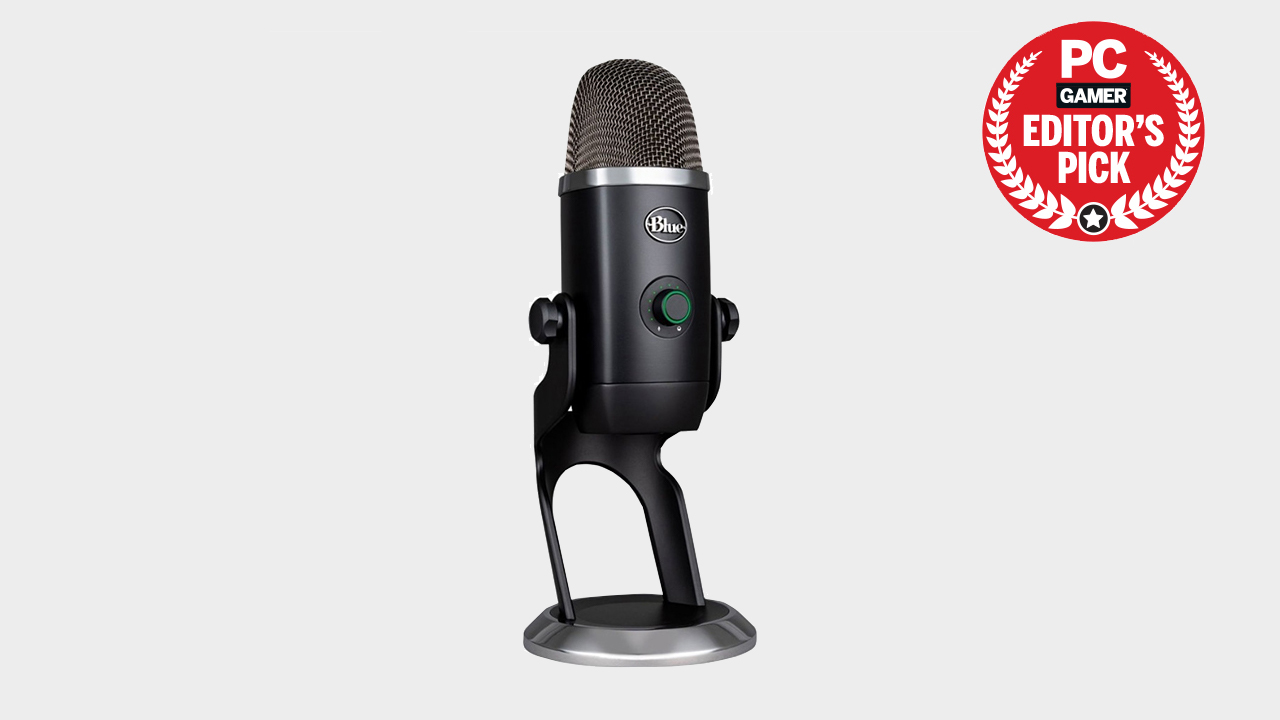
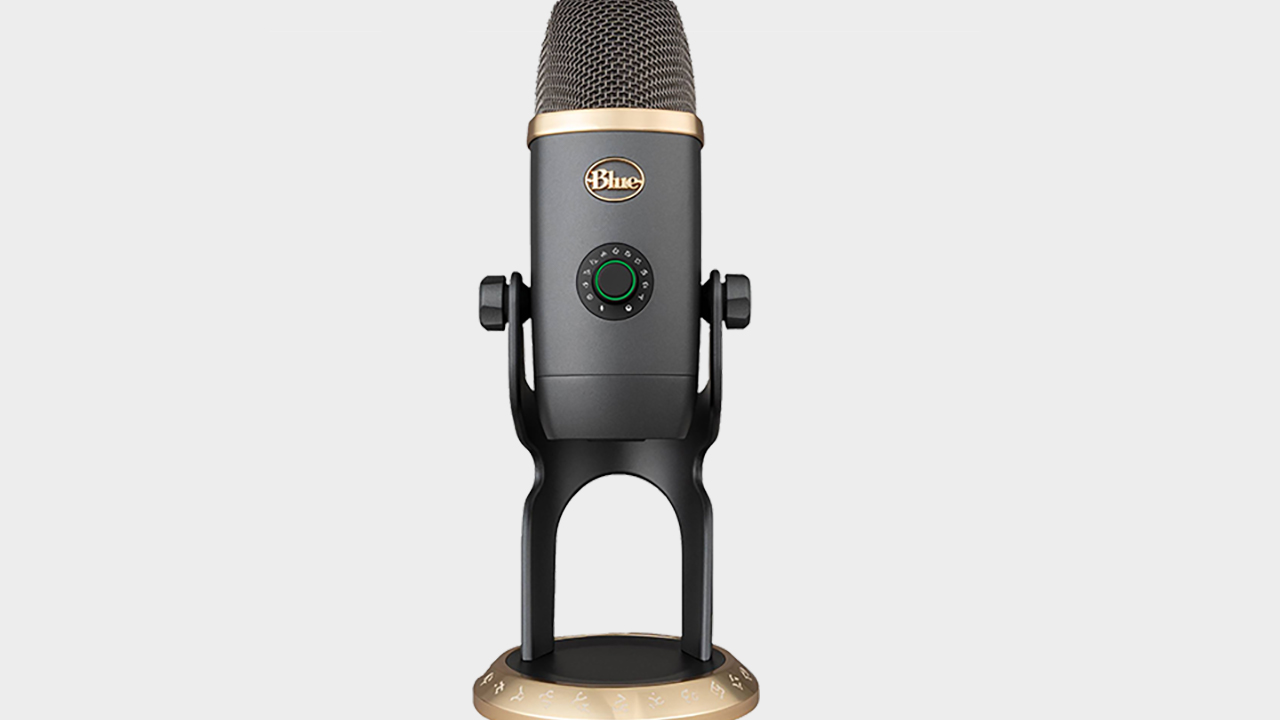
There's a reason Blue microphones tend always to have a place on our list. The Blue Yeti X is a hybrid model of the Nano and the original Yeti, an amalgam of the better bits of both. Even as new microphones enter the space, the Yeti X continues to be a reliable recommendation for anyone looking for a great-sounding mic.
The sturdy microphone now has an LED-lit front panel that usefully monitors your volume levels at a glance, and the sound quality remains top-notch. This 'Smart Knob' functionality also allows on-the-go tweaks to gain, headphone levels (while using the built-in 3.5mm jack), and blend modes. That means you can adjust how loud you are in your headphones, how loud you sound to others and the volume of your headphones all from the front of the unit.
It's clear why this is still the mic of choice of many professional podcasters and streamers.
On the back of the Yeti X there's a single button that switches through the four pickup patterns on offer. There's cardioid for recording and streaming, omnidirectional for big calls with lots of people, bi-directional for two-person podcasts, and stereo for... well ASMR, apparently.
When it comes to microphone quality, it's clear why this is still the mic of choice of many professional podcasters and streamers. It's crisp and clear, with an impressively wide range that feels like it represents your voice clearly in recordings.
The downside to this mic is it's quite chunky, but the included stand does a great job of keeping it stable on a desk. It also does okay at keeping vibrations from shooting through it and into the microphone, causing annoying feedback. Your best bet to reduce this further will be a boom arm with some form of suspension, however.
Blue recently released a World of Warcraft Edition Yeti X, too. That's the one pictured above from our testing. It offers the same features as the Yeti X, except it's rocking a nice black with gold trim design along with some neat fantasy glyphs all over the mic. More importantly, it lets you choose to voice to various Warcraft races like gnomes, imps, and of course, Orcs.
If that's not your thing, you can find the Yeti X in a range of colors to suit most PC builds and desktops.
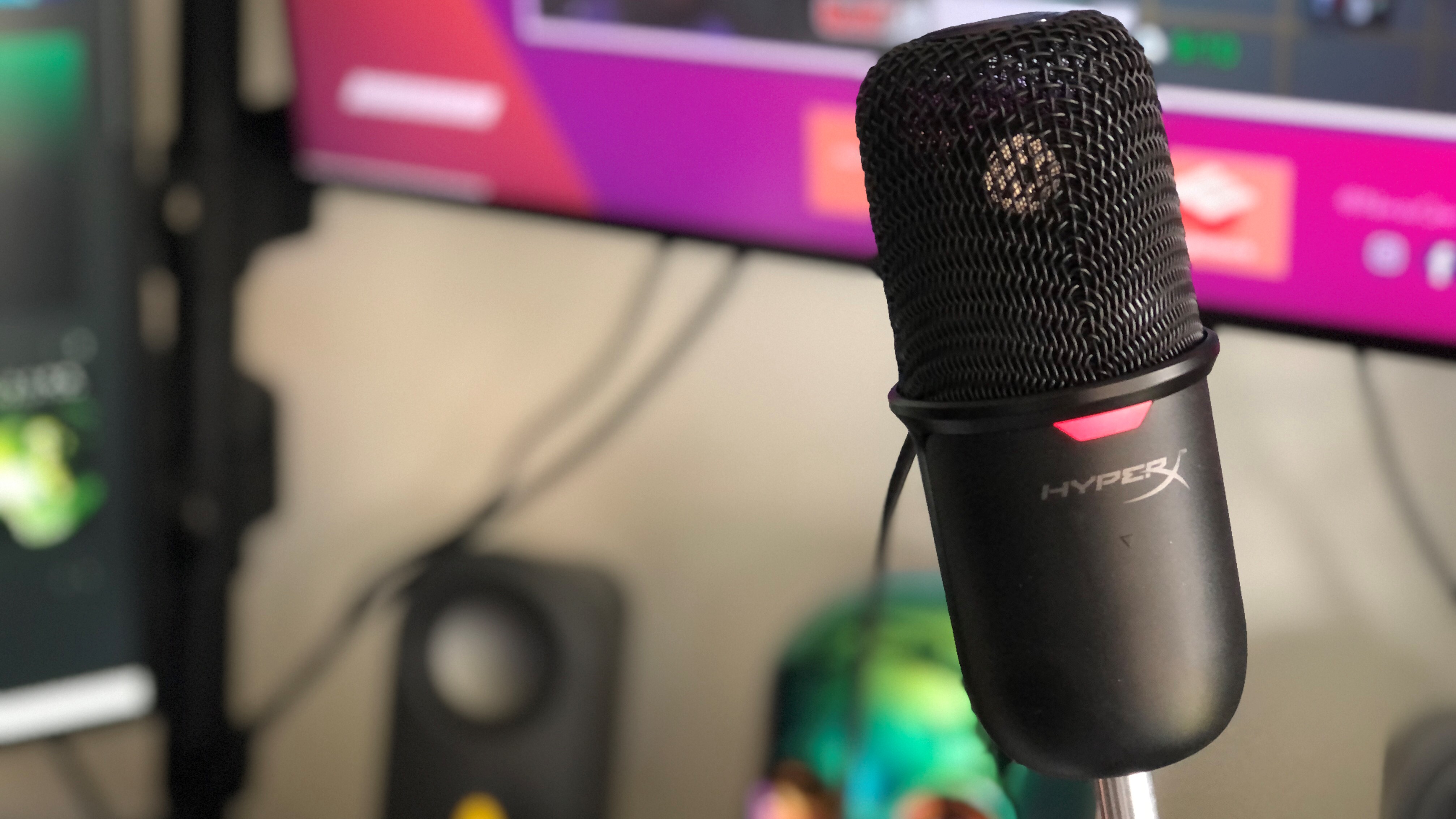
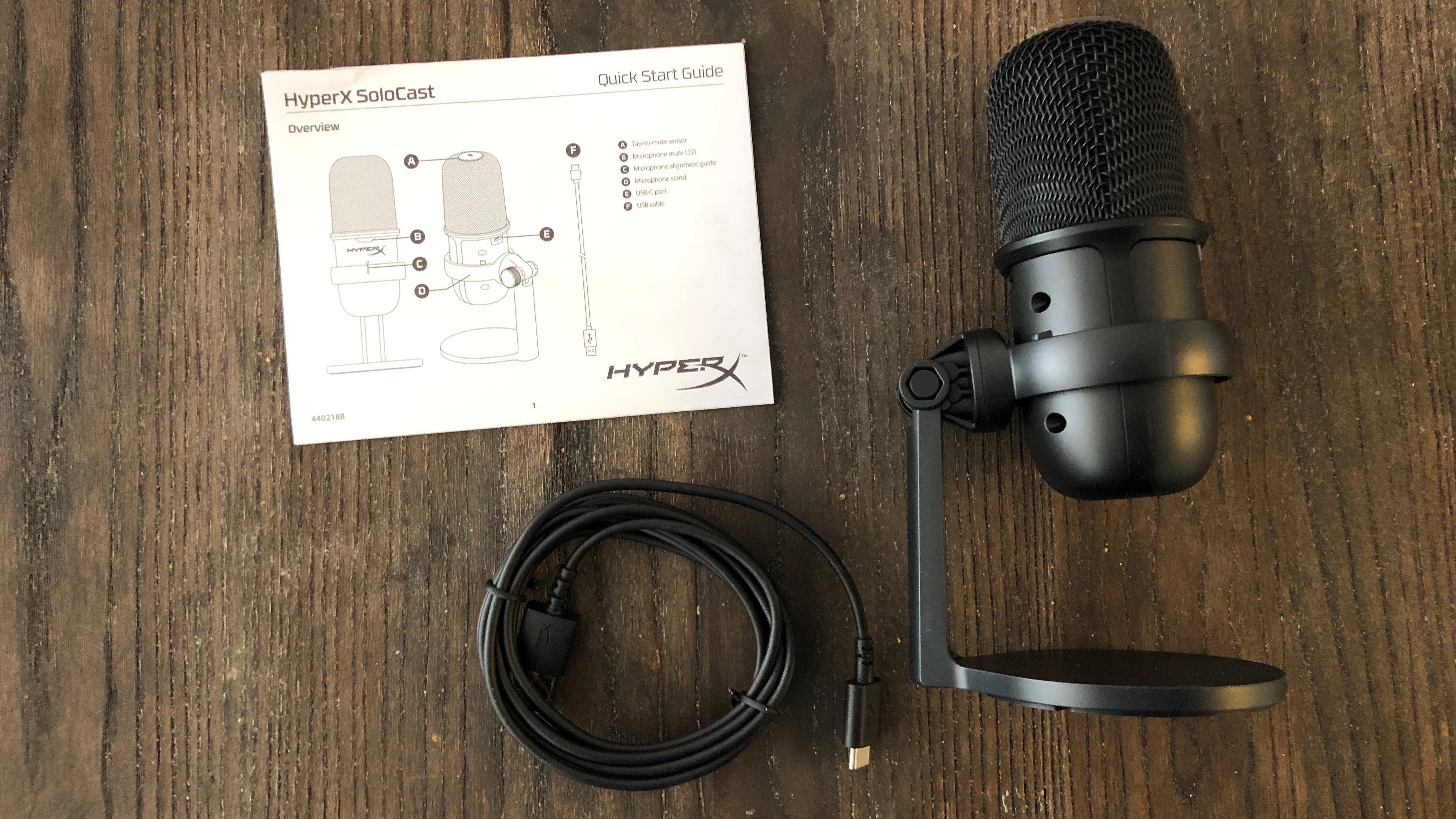
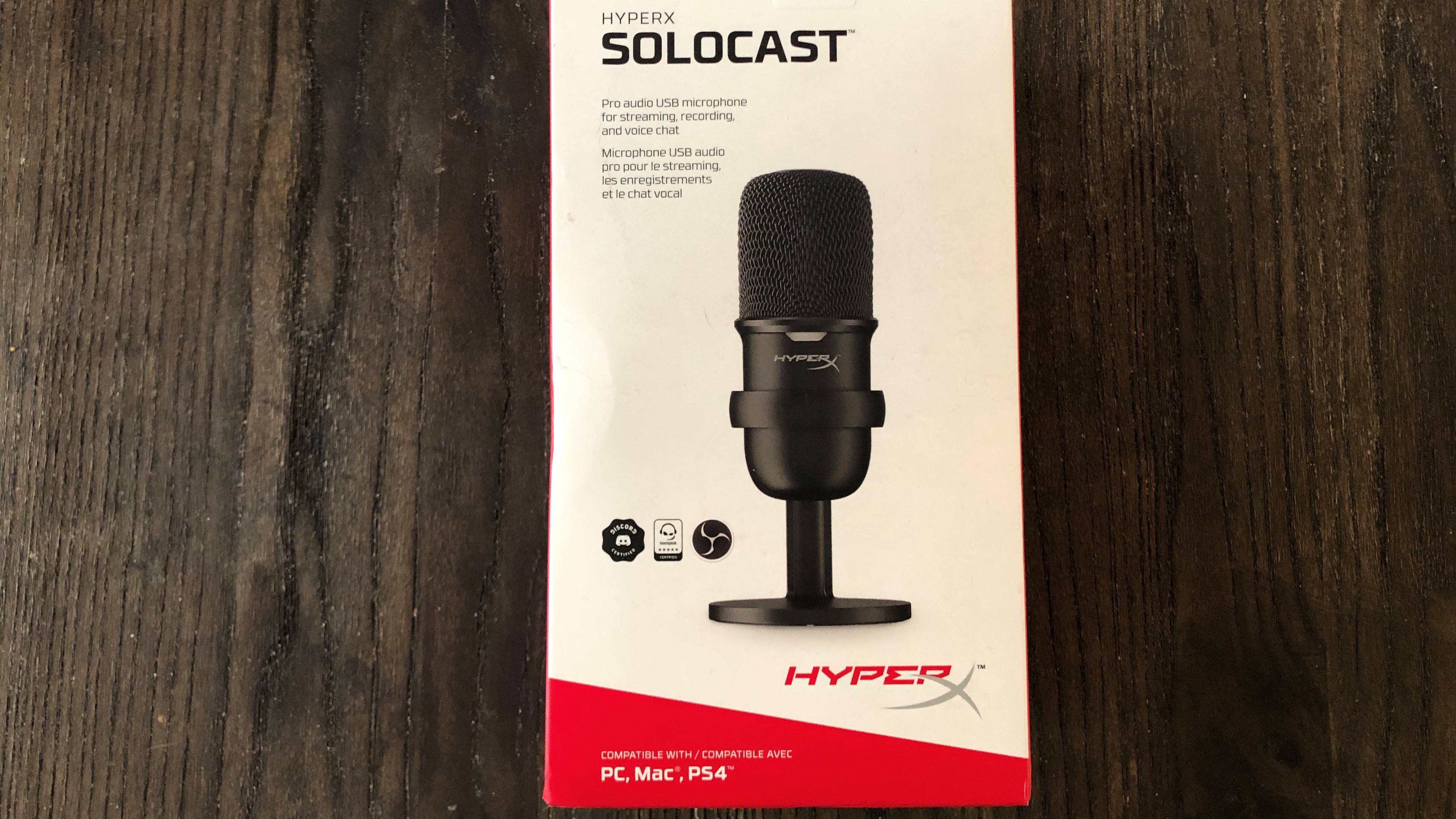
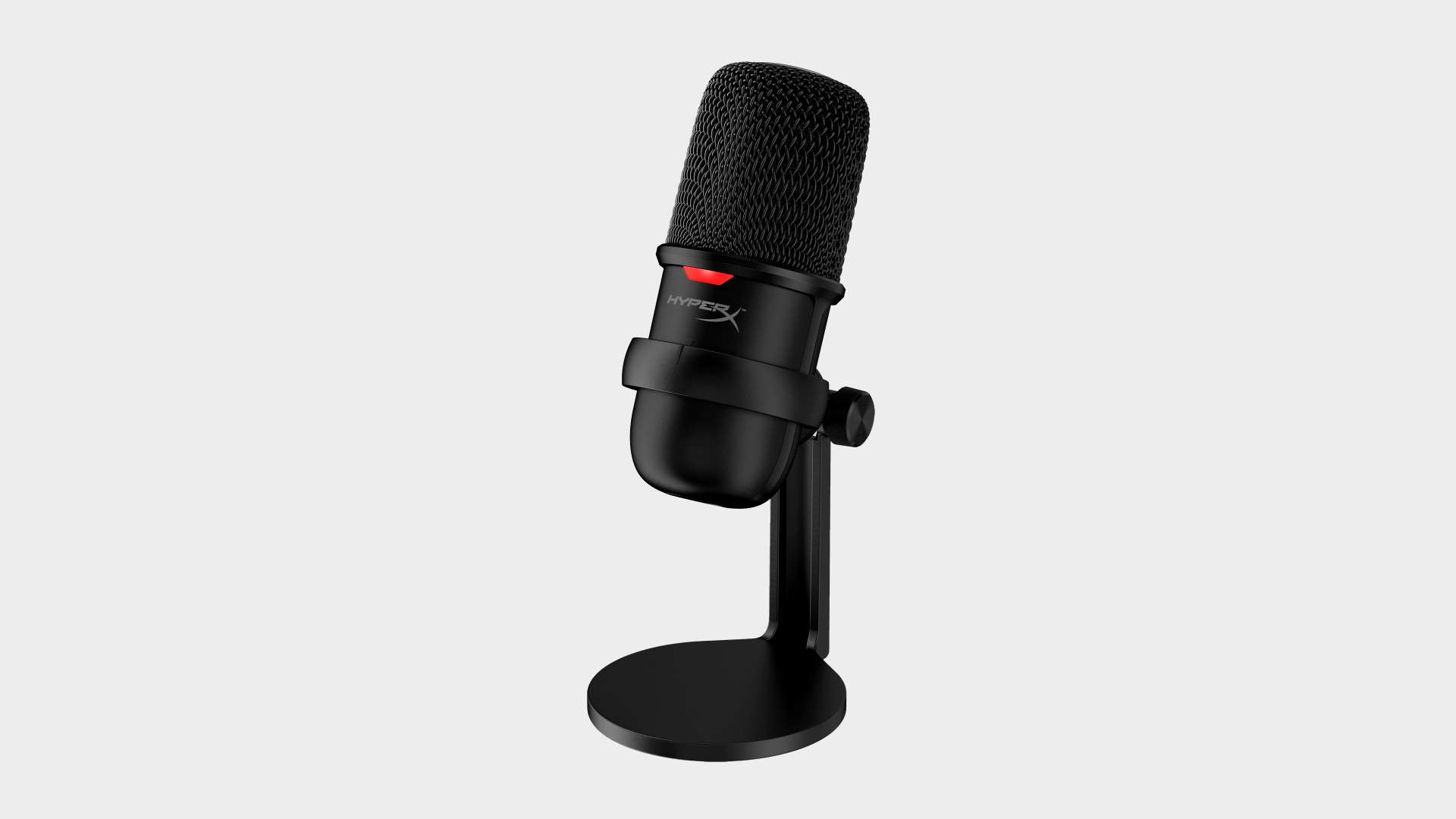
The HyperX SoloCast is the best of a slew of new budget-oriented microphones. This new breed delivers their more expensive siblings' audio performance, prioritizing the sound over extensive feature sets for a frankly fantastic price.
For less than $60 you're really paying for the portability and ease of use. As far as sound quality is concerned, you usually get what you pay for, but the HyperX SoloCast is hoping to prove that a microphone that's cheaper in price doesn't have to mean cheap sound.
With the JLab Audio Talk GO and Razer Seiren Mini all offering great sound, the HyperX SoloCast stands above the others because it gives us the audio chops of its pricier QuadCast S compatriot. That's a fantastic microphone in its own right, and we can bear losing the full list of features and range of polar patterns when we want an easy plug-and-play mic.
The SoloCast has just the single cardioid polar pattern.
The SoloCast seems to take a 'sound over anything else' approach, much like its wildly successful HyperX Cloud gaming headsets have. HyperX has stripped down one of its QuadCast mics down to the bare essentials. I reviewed the $160 HyperX Quadcast S and fell in love with its sound and the number of smart quality-of-life features on the microphone, which set it apart from other mics.
When comparing the HyperX SoloCast and QuadCast S, the sound quality is scarily similar when using cardioid mode across both. Both mics have a 20Hz-20kHz frequency response and a 16-bit sample rate. So the quality of sound is there if that's your chief concern. Unlike its namesake, the SoloCast has just the single cardioid polar pattern as opposed to the four that are offered on the QuadCast mics.
The features HyperX has sacrificed to the audio gods are a headphone jack, gain control, shock mount, internal pop filter, and, let's not forget, that fun-looking RGB lighting. All gone with the simplistic SoloCast.
The gain control is particularly missed, as not being able to regulate the gain on the fly with the SoloCast is a pain since the mic sounded just a bit too hot out of the box. This means any changes you need to do have to be done on the software level in your streaming apps, such as OBS or XSplit.
But if you're just after higher-quality audio and don't want to mess around with gain settings mid-stream, the SoloCast could be all the mic you need.
Read our full HyperX SoloCast review.
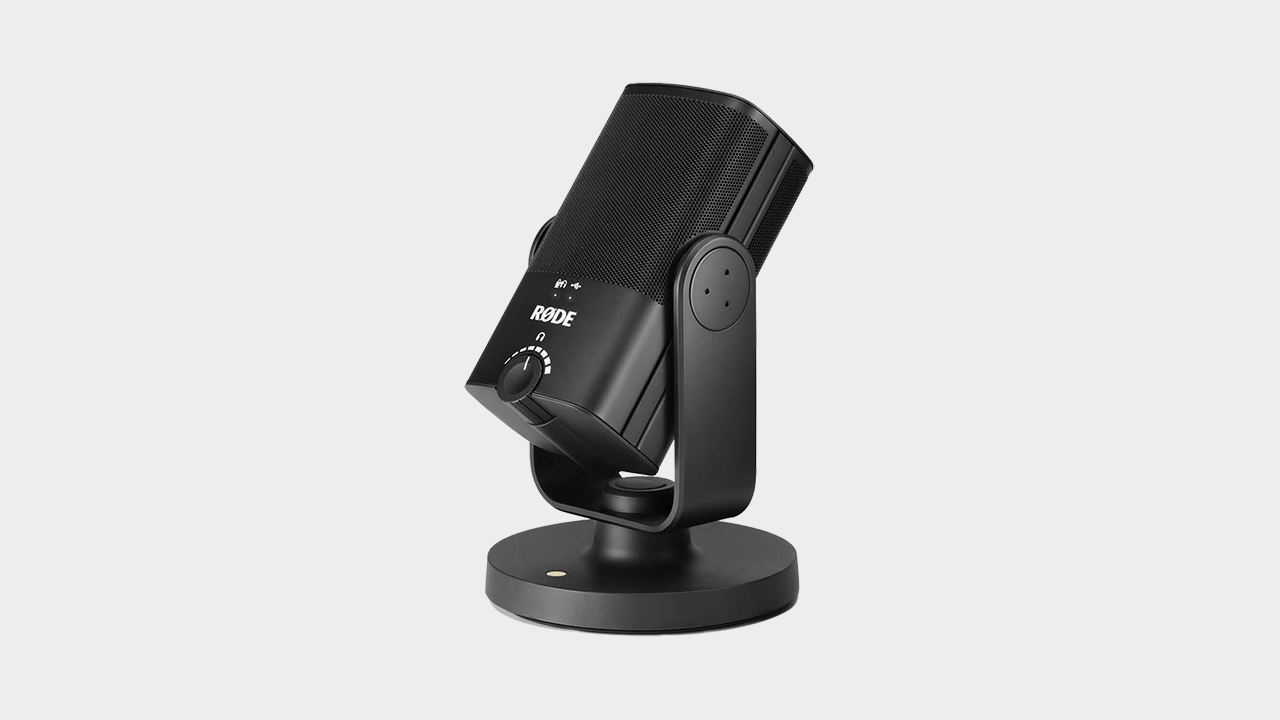
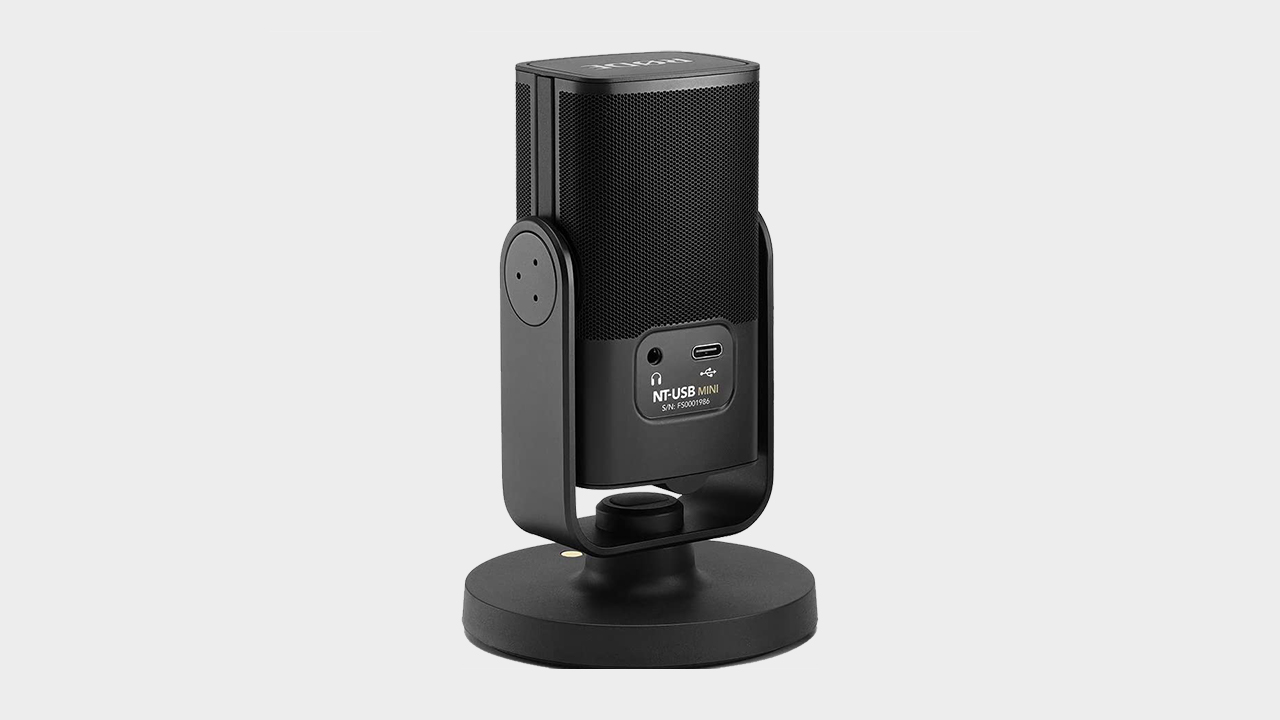
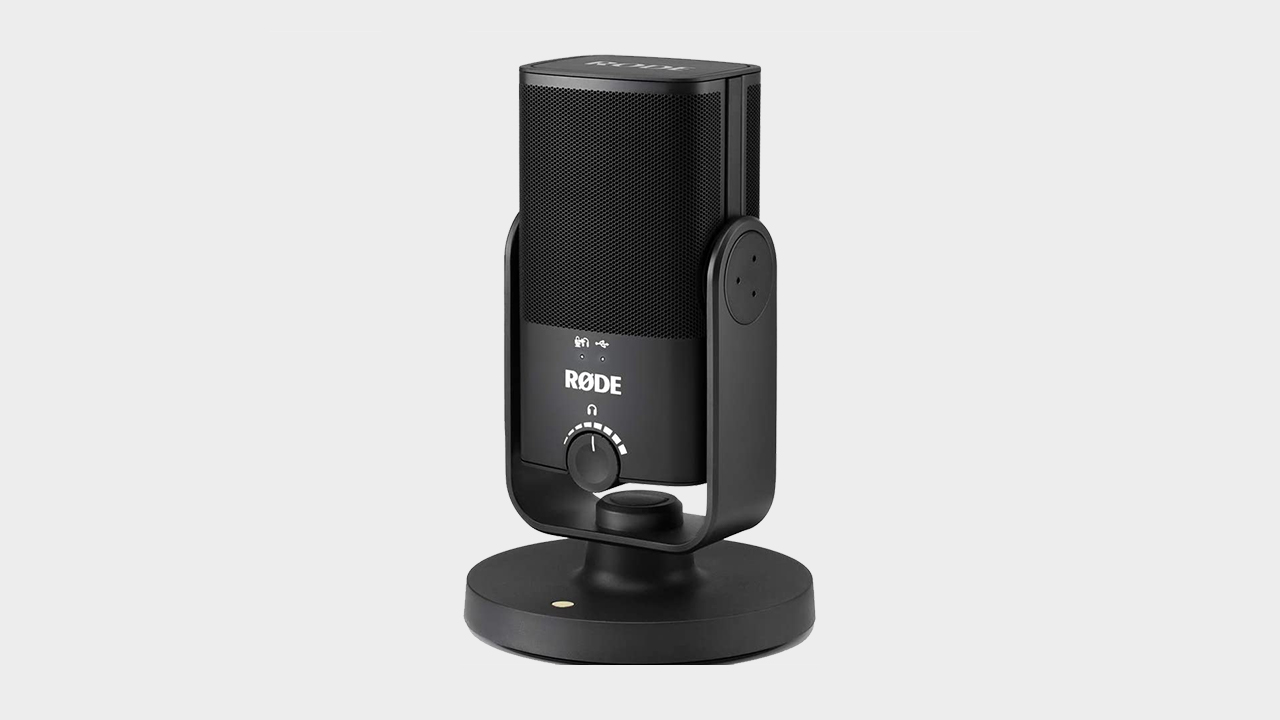
As tiny mics go, the Rode NT-USB-Mini is an impressive offering from Rode. It takes everything I want from a premium mic and shrinks down to something more affordable but still retains the top-tier audio quality we've come to know from Rode. It's a solid-sounding microphone despite its tendency to pick up some background noise. The $100 Rode microphone seems a bit unbelievable, but somehow it's a reality.
Years ago, we reviewed the Rode NT-USB; the NT-USB Mini somehow manages to shrink that mic down even further. Now it's a cute little recording cube, but it also offers some subtle, smart design improvements. The first thing you notice is that yes, this thing is tiny. It's just 90mm wide and 141mm tall.
Taking cues from other smaller mics like the Razer Seiren Mini, Rode has stripped a lot of the usual features you'd find in the standard mic for a more no-fuss, no-muss design approach. The Mini has a built-in pop filter to deal with your plosives and a neat little detachable magnetic stand that makes for easy traveling.
Rode has always been known for its top-tier audio gear.
Though the NT-USB does offer some useful features. Zero-latency monitoring mode removes the delay of your voice in playback. That's important because, depending on the type of setup you have, it can be super distracting to hear your own voice a few milliseconds after speaking. This deals with all that rather well.
The Rode NT Mini's digital mixer, Rode Connect, allows for up to four Minis (and only Minis) to be plugged into a PC. It may not seem like a big deal, but most people would be shocked to know that trying to get multiple USB mics to work on a single computer is a nightmare. It often confuses your recording software or, worse, makes all the mics share the same track, which makes it near impossible to edit.
That's great for podcasts, or streams featuring multiple people, along with being a pretty handy tool for folks who hate dealing with messing with audio settings during a stream.
Rode has always been known for its top-tier audio gear. It is often a strong recommendation for anyone looking to upgrade from semi-pro to pro streaming or podcasting status. The cost has always been a sticking point, however, since Rode's gear has always been traditionally skewed towards the serious prosumer. The Mini's $100 price makes it a good choice for anyone looking for a quality microphone that travels well and keeps its traditional Rode durability.
From the test recordings, you can hear that the quality of the mic is good, if not better, than more expensive microphones on the market.
Read our full Rode NT-USB Mini review.
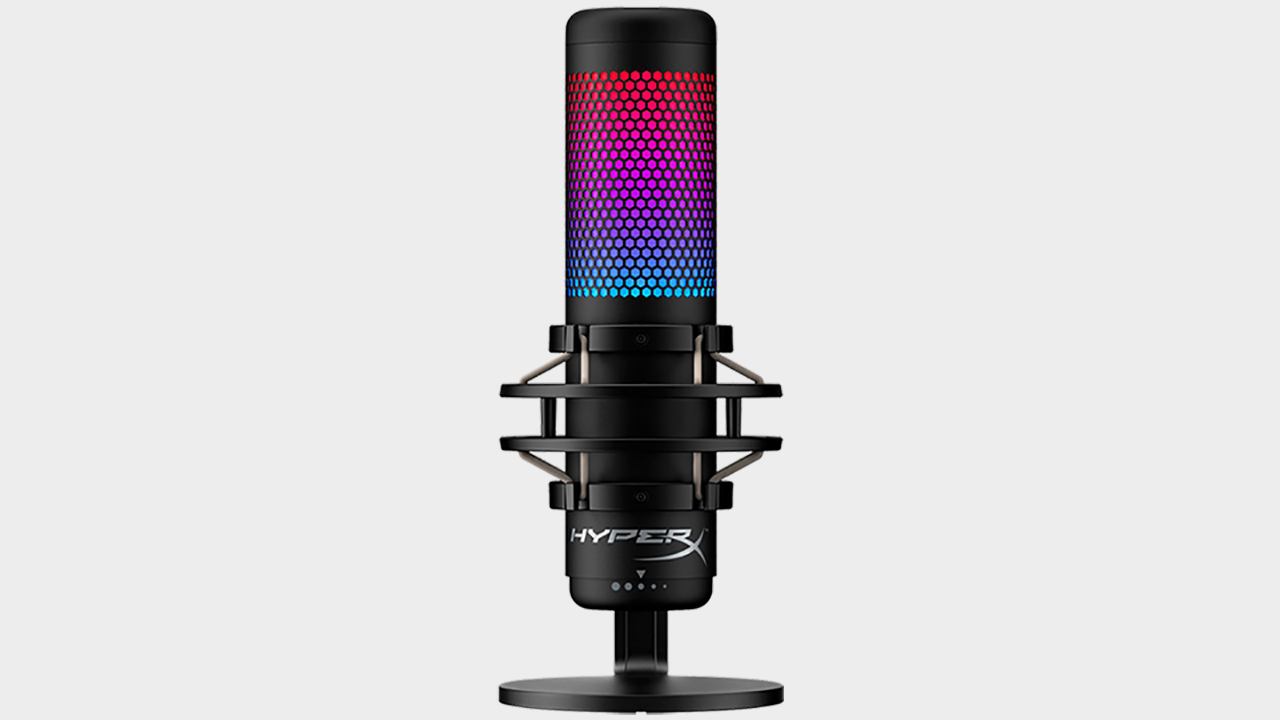
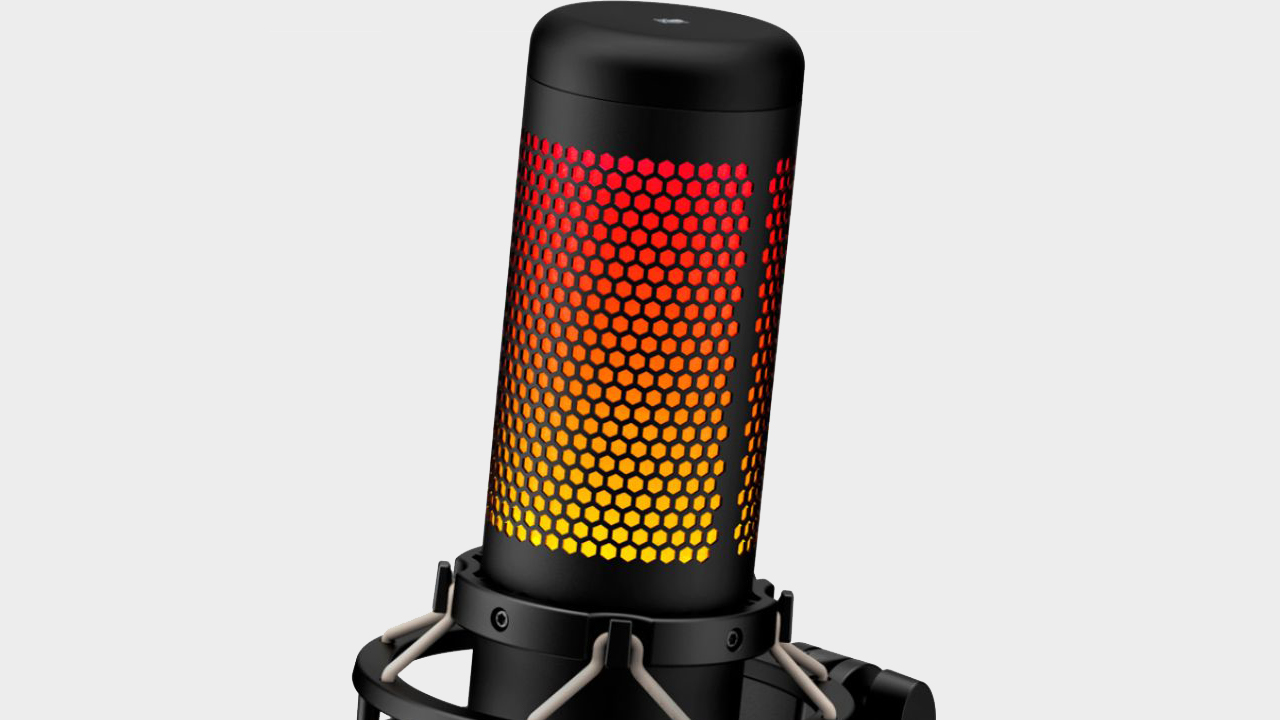
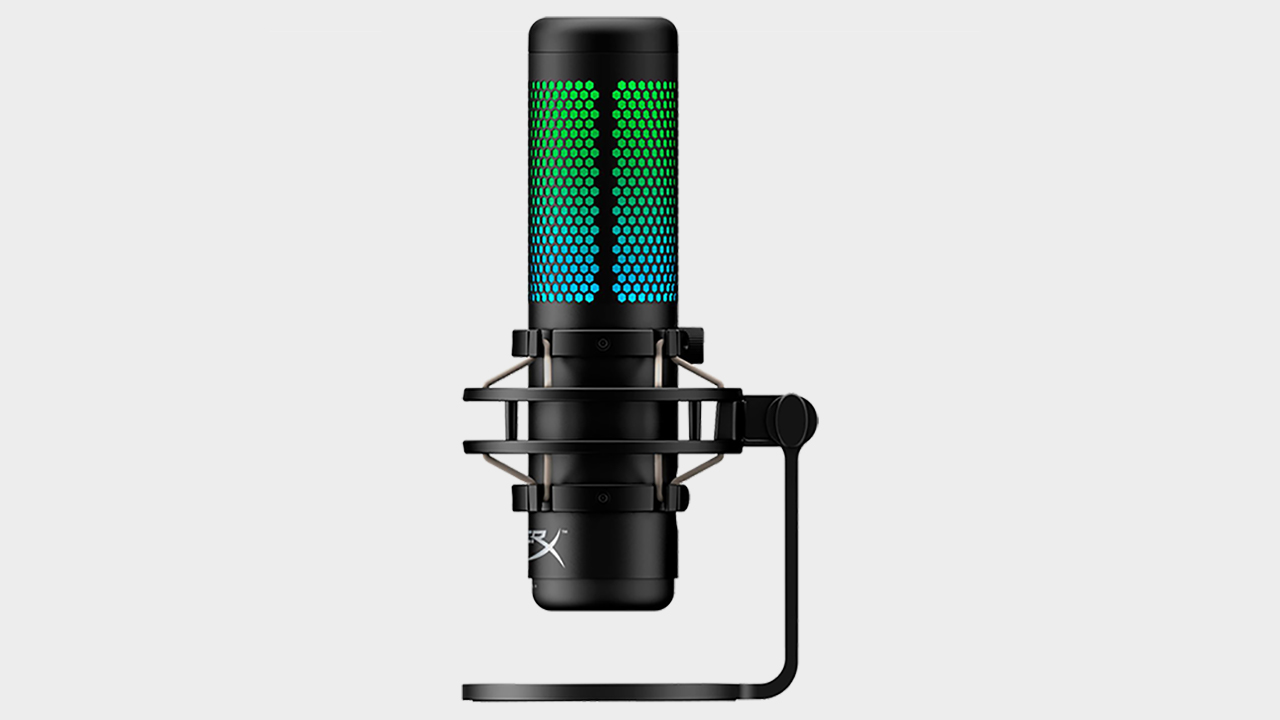
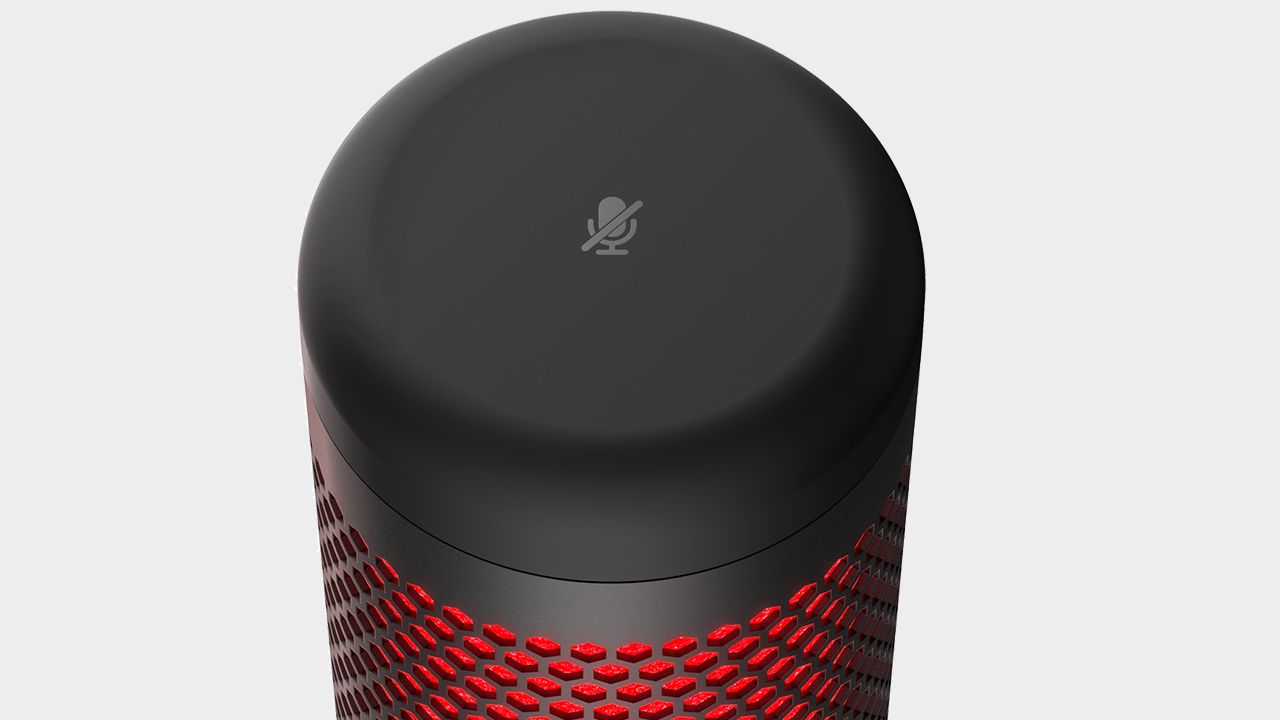
The gamer-centric HyperX Quadcast S is an excellent microphone for the gamer or streamer looking for an easy-to-use, clear-sounding mic. While it doesn't quite match up to the Yeti X in terms of sound quality, the Quadcast S makes up for it in design and feature set.
The biggest draw of the Quadcast S is that it's loaded with built-in features that usually end up being pricey add-ons for other streaming microphones. The built-in shock mount prevents the mic from picking up any accidental bumps that happen during a contentious Warzone match or overly active Discord chat. The built-in pop filter is also a nice touch considering I always have issues trying to find the optimal position and distance for my rink-a-dink $7 pop-shield, and it never quite stays where it's supposed to when mounted.
The touch-sensitive mute button at the top of the microphone is excellent, too. Often mute buttons and switches make a loud click when recording. This doesn't. The Quadcast S hits the sweet spot of price, sound, and features if you're looking to add something to your live stream.
It looks like you're speaking into a lava lamp.
Specs-wise, the S is more or less identical to last year's Quadcast, offering the same frequency response of 20Hz-20kHz, bit-rate of 16-bit, three 14mm condensers, and lets you choose between four polar patterns. Though my plosives tended to sound a little more blown out than I'd like, the quality of my voice sounds good. During conference calls, I can be heard clearly with numerous colleagues commenting on how much louder I was than anyone else, which is an easy fix by bringing down the gain.
On the software side of things, the HyperX Quadcast S uses its proprietary Ngenuity software to handle all things RGB, and that's pretty much it. I mean, you can adjust things such as the mic level and get a description of each polar pattern. But other than that it's pretty light in options when compared to the Elgato Wave: 3, which comes with a digital audio mixer, or Blue Yeti X's Blu! Voice software that lets you apply audio filters.
It still retains its sports-talk radio broadcast mic look, which isn't for everyone, but I think it has a certain charm. I love the dynamic RGB lighting, anyways. It looks like you're speaking into a lava lamp.
While the RGB is impressive and fun, it doesn't merit an upgrade for existing Quadcast owners, since the microphone is the same from last year except for the lightshow. But if you're choosing between the Quadcast and Quadcast S, the dynamic RGB is neat and loud, which could always deter anyone after something more low-key. If that's the case, the Quadcast is probably more your style (and you'll save around $20).
Read our full HyperX Quadcast S review.
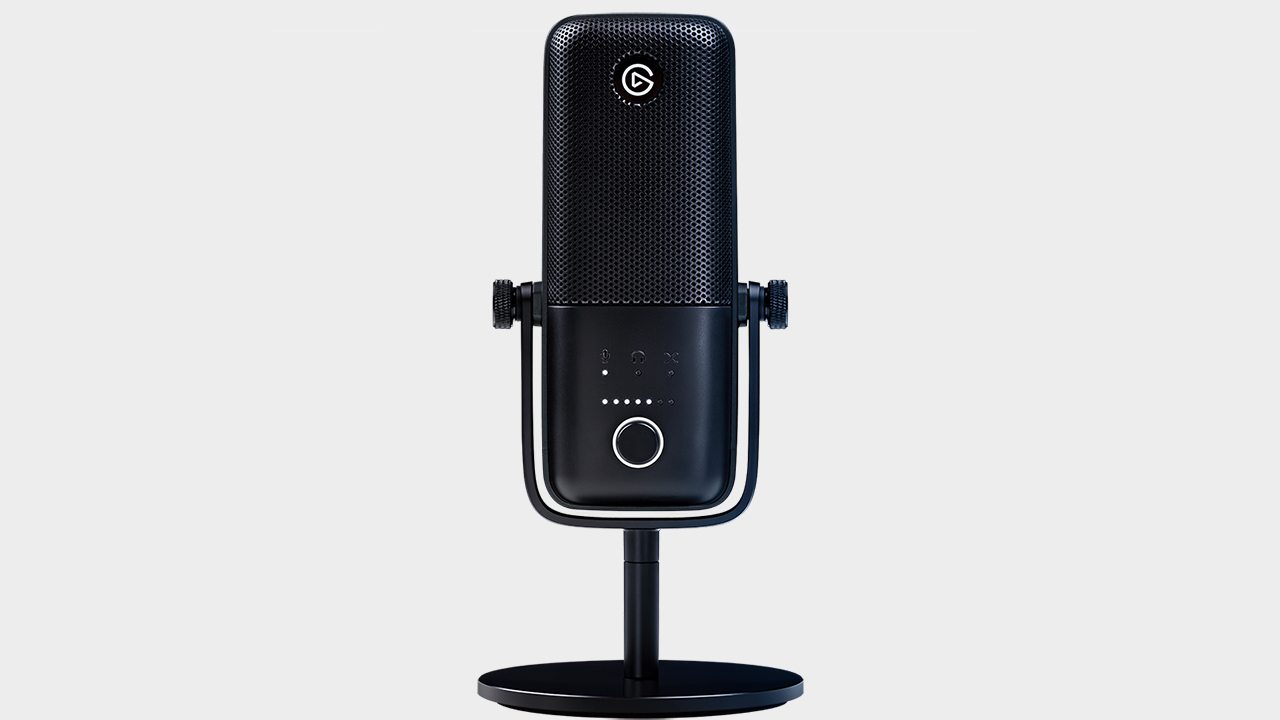
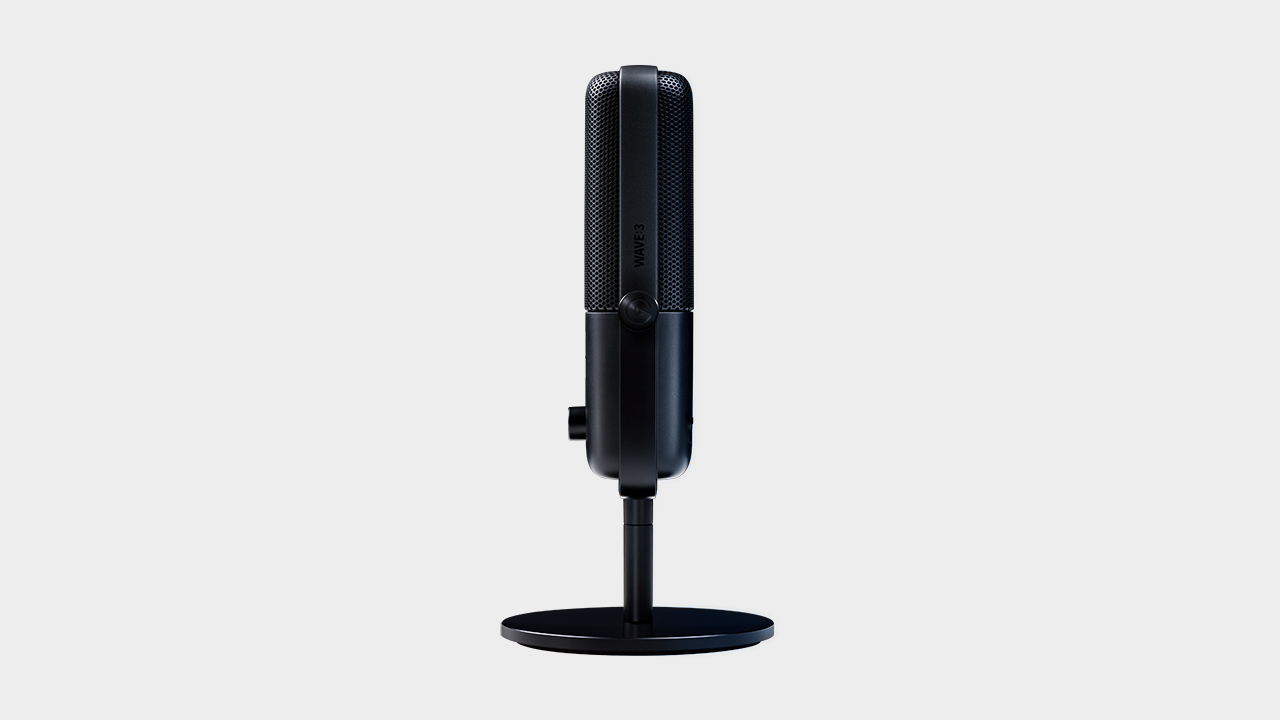
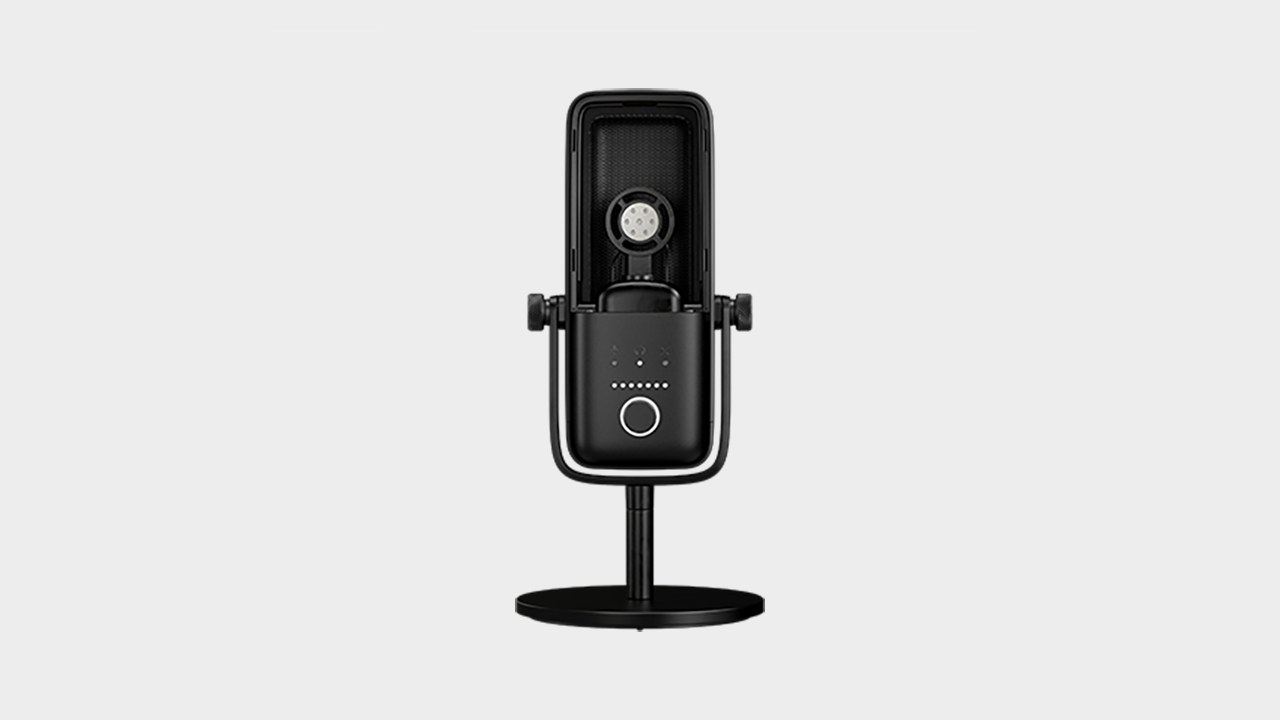
Elgato's debut microphone is aimed at streamers looking to add quality audio to their streams with minimum fuss. The Wave 3 is a feature-packed 96kHz microphone that sounds incredible, is easy to use, and is compatible with most desk boom arms.
The Wave 3's design finds an excellent middle ground between looking modern while still hitting the same aesthetic notes as an old-timey microphone. It's a look that's grown on me over time. But what I especially like is how easy it is to set up on even the cheap $18 boom scissor arm I have mounted on my desk. An included boom arm adapter didn't require me to order any special shock mounts or anything. The capacitive mute button is also a nice touch.
The single cardioid polar pattern ultimately limits the Wave 3's versatility.
Elgato's custom software, Wave Link, works as a digital audio mixer that controls all aspects of your stream from one place. You can put up to 8 channels for game audio, multiple microphones, even game chat. Xsplit and OBS users can add Wave Link as a master audio source, which is a lifesaver. Most streamers will tell you that the most annoying and unpredictable part of a stream is always the audio.
Handily, the Elgato's Clipguard tech automatically adjusts your levels from ever hitting red. Clipguard "automatically soothes overdriven soundwaves before sending them to your computer." This means the microphone will automatically adjust your levels as you stream. So, even if you're blowing out your microphone in real-time because you're having a screaming fit after a BS death in Fortnite, the Wave: 3 will do its best to make sure your loud screeches of defeat don't blow out anyone listening to your stream.
Most importantly, the Wave: 3 sounds pretty great. Even with the gain set on the lower end, you can listen to every little detail in my post-date night hungover voice, right down to the smacking of my dry lips. I should drink more water. My party members in Call of Duty Warzone said I sounded pretty clear along with my coworkers during conference calls, though I will recommend again keeping your gain low, so it doesn't pick up the hum of your PC while you're trying to talk to teammates.
The single cardioid polar pattern ultimately limits the Wave 3's versatility, but this is a decent option if you're looking for an easy-to-use microphone for your next stream.
Read our full Elgato Wave 3 review.
Best gaming headset | Best gaming monitor | Best HDMI cable for gaming
Best computer speakers | Best SSD for gaming | Best CPU for gaming
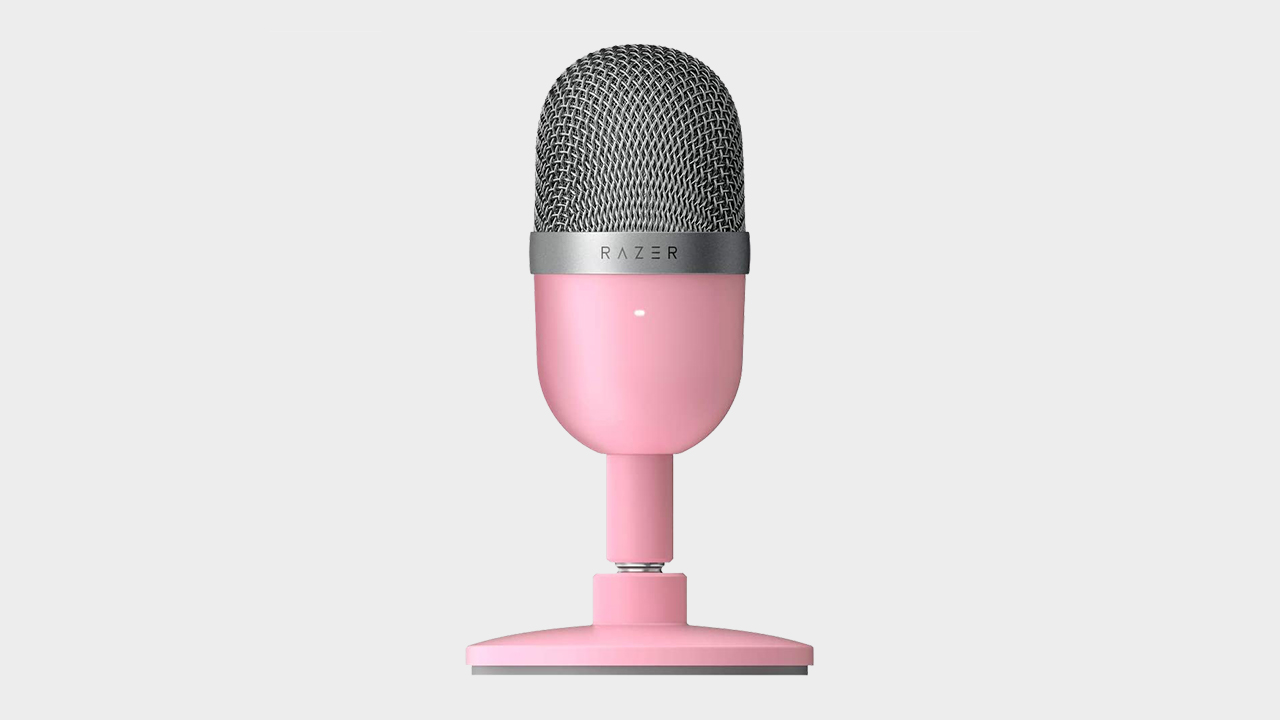

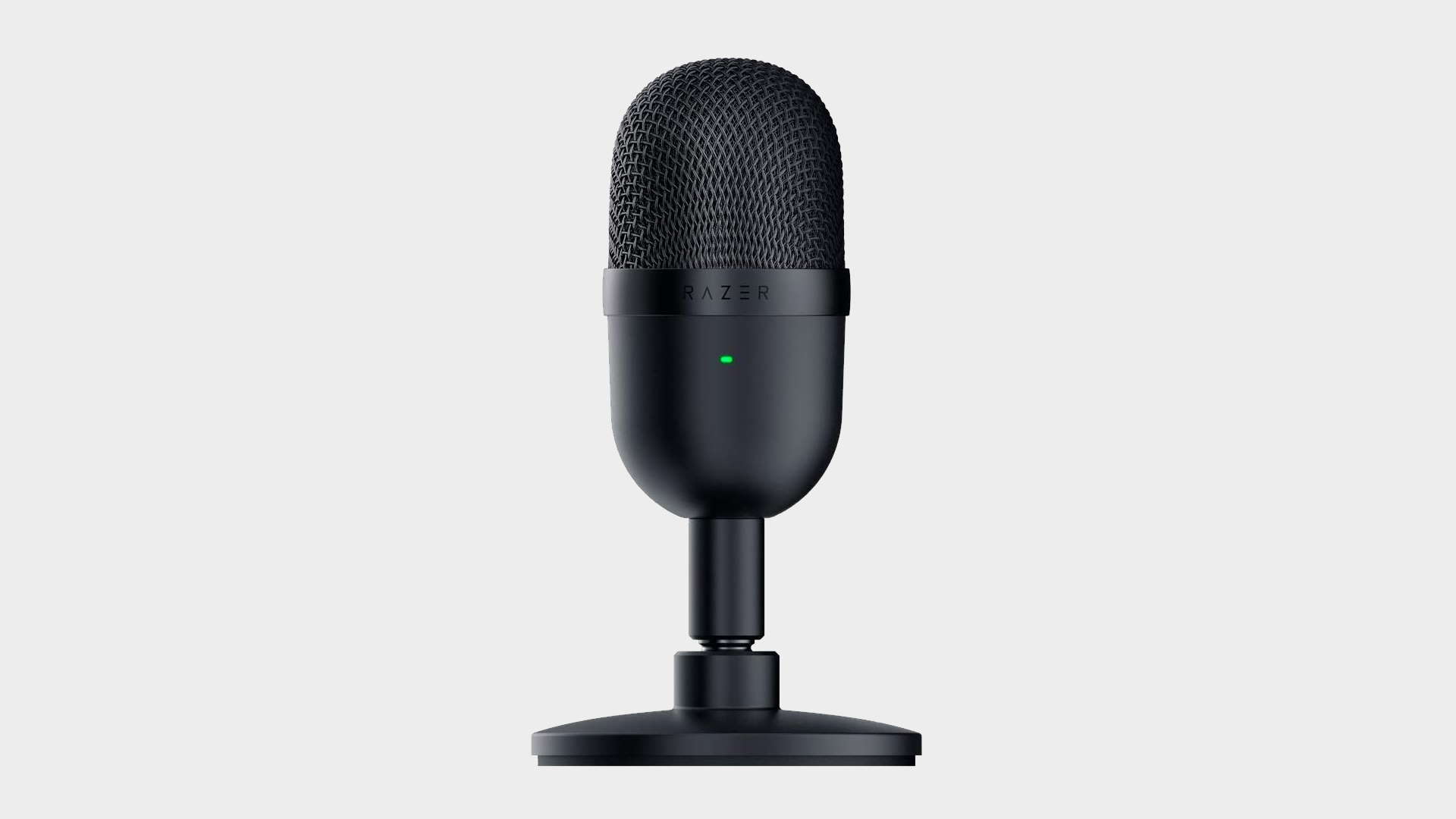
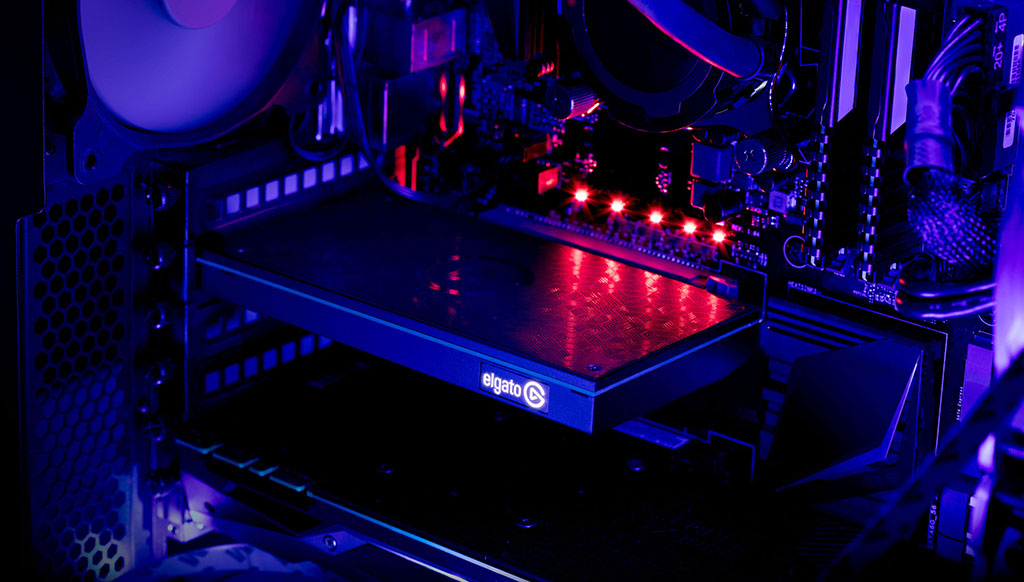
Best webcams: be seen while you get your stream on
Best capture cards: lessen the load with a dedicated card
The Razer Seiren Mini is one of those obnoxiously adorable pieces of hardware I instantly want to put on my desk. Its stylish design and color variety give the Mini the personality lacking in some of our other choices on this list. And it sounds great, to boot.
Much like the HyperX SoloCast, many features were stripped away from the Seiren Mini to keep the sound quality up and the cost down. There's no volume or gain dial. Hell, there isn't even a mute button. What the Mini lacks in features, it makes up in price and sound.
The Seiren Mini's adorable pill-shaped design comes in your choice of Black, Mercury White, and Quartz (pink). Out of the budget mics out there, the Seiren Mini's design is the most eye-catching. I was sent a Mercury White microphone, and it's one of my favorite-looking pieces of hardware I've gotten this year and pretty darn cute. Razer has been slowly adopting some design cues from Apple, especially when it comes to its gaming laptops.
The Seiren Mini is a perfect entry for Razer's already reliable line of microphones.
As you can hear above, the Seiren Mini sounds just as good as Razer's more expensive Seiren offerings. The Mini's super-cardioid polar pattern does a better job of tapering down background noise to focus on what's in front of it, though it does sound a bit softer than the Seiren Emote at its default gain. HyperX SoloCast sounds slightly better than the Mini but not much, which is an impressive feat on its own considering how much the SoloCast has impressed us.
The Seiren Mini is a perfect entry for Razer's already reliable line of microphones. Its ultra-portable size and pricing give streamers another good option for a budget microphone. The lack of a mute control and some other quality-of-life features will take some getting used to for any more pro folks, but they'll be aiming their sights higher up the product stack anyways.
Some people won't get over the fact that there's no mute button, and the proprietary micro-USB is a bit of a pain. I would have loved to have seen a ⅝ to ⅜ thread adapter so that it'll mount on most boom arms, too. Even so, the Seiren Mini makes for an excellent starter mic for budding podcasters and streamers.
Read our full Razer Seiren Mini review.
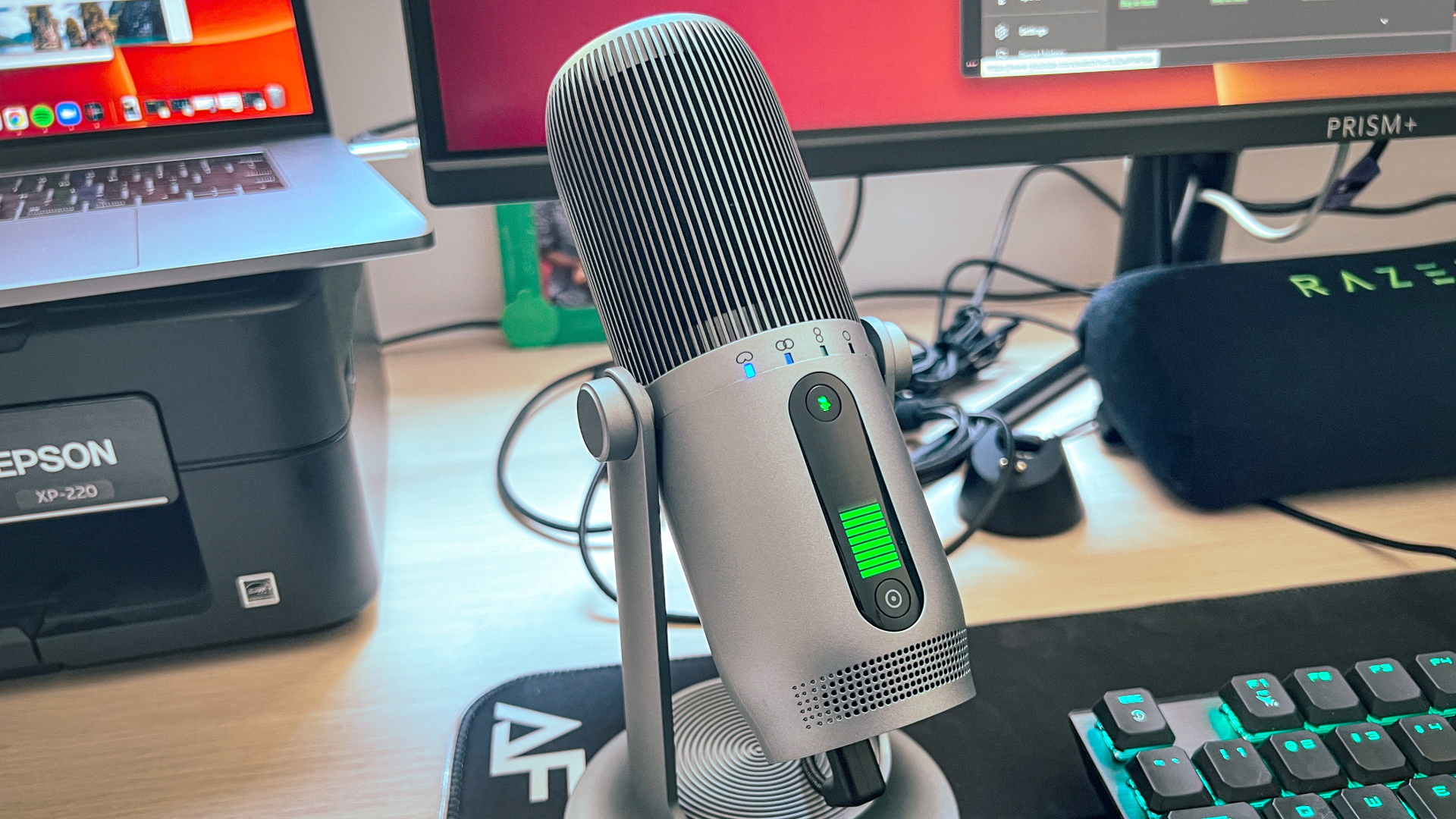
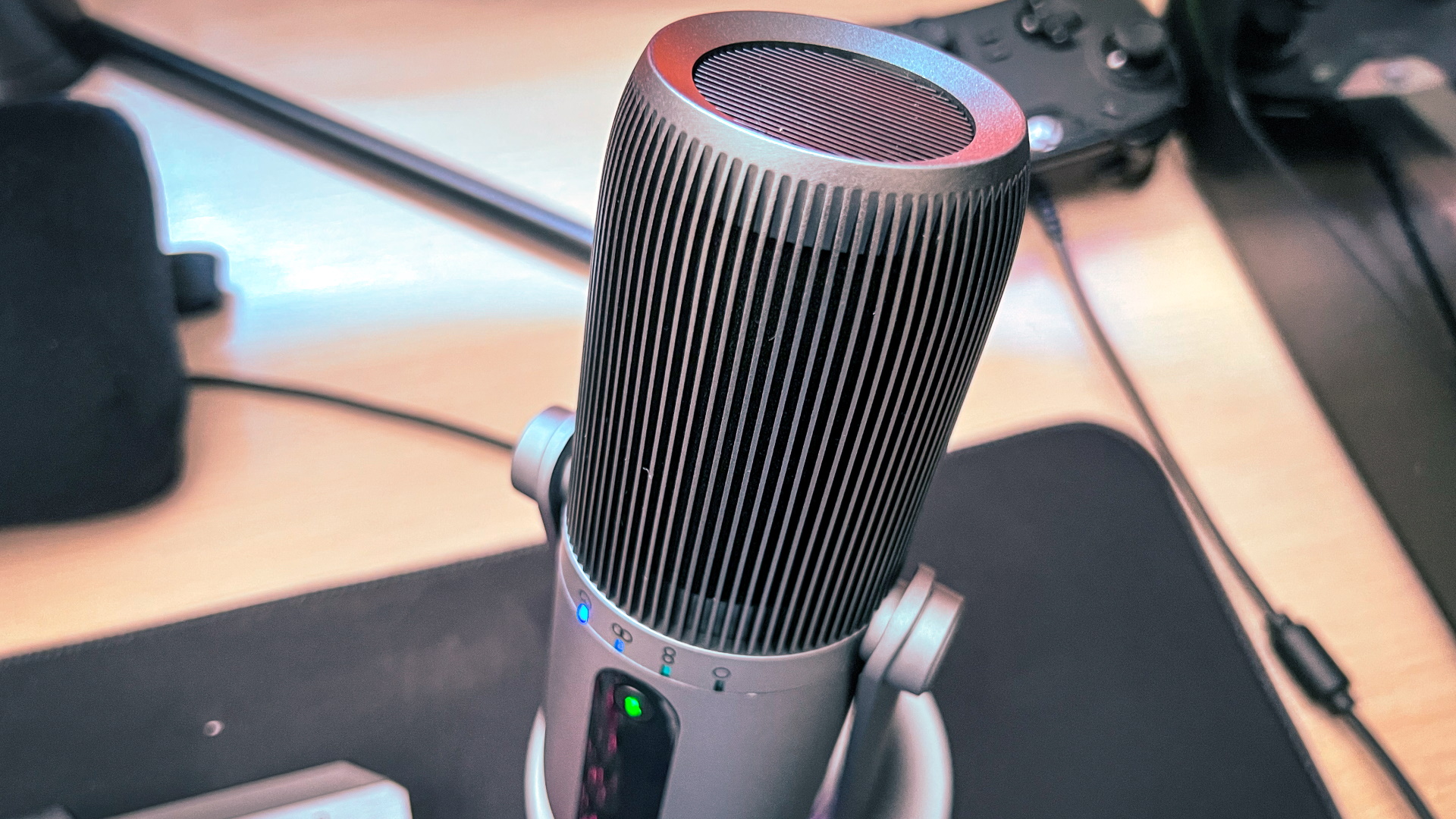
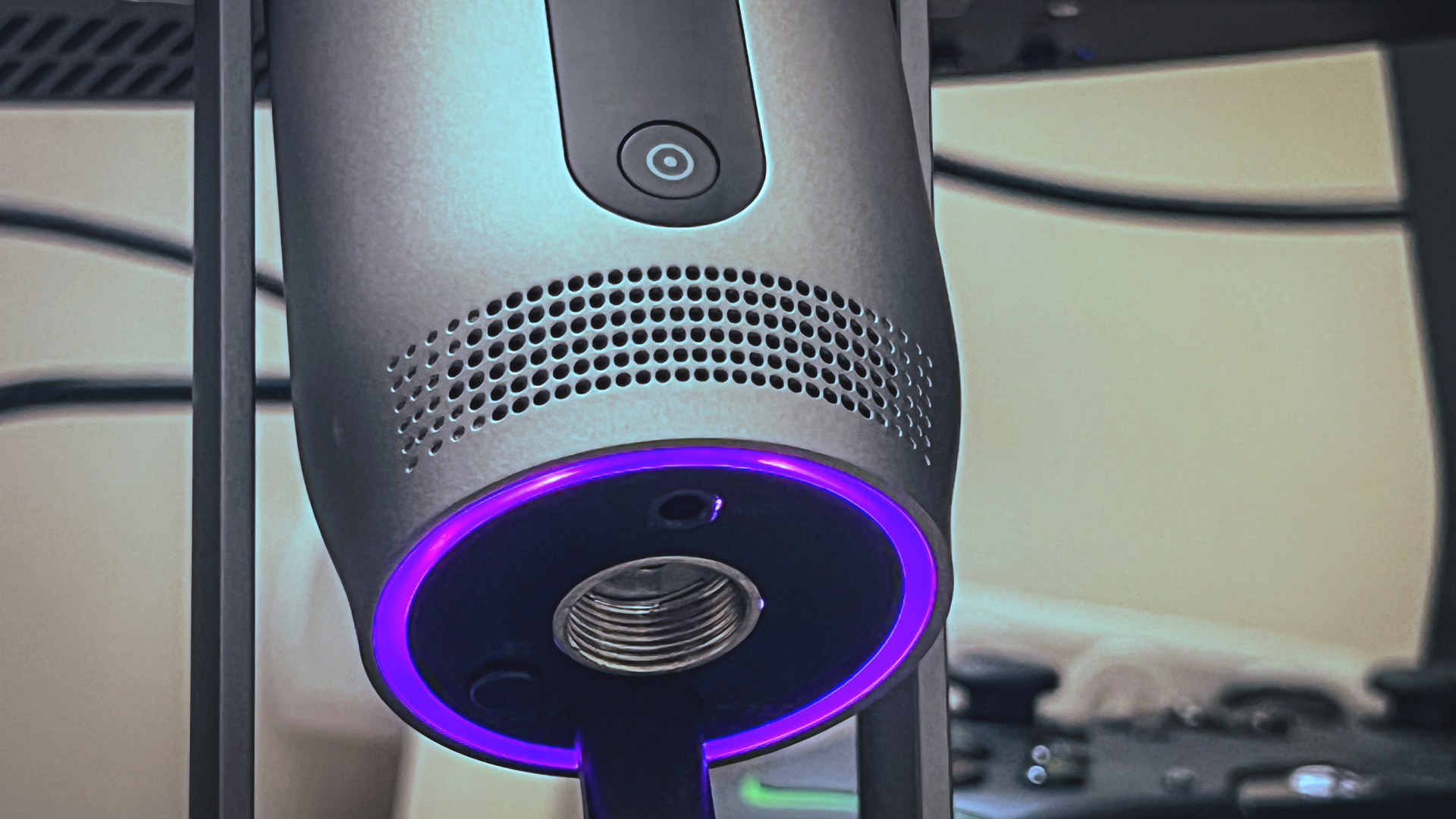
The Thronmax MDrill One Pro is the most surprising microphone I’ve had the pleasure of reviewing in the past few years. The $90 Thronmax MDrill One Pro is a USB Condenser microphone that works with Windows, Linux, MacOS, and PlayStation 4 and 5.
It's a plug-and-play mic, and I can’t stress enough how happy I am that I don't need to use some overly complex software to get the most out of it—I’m looking at you Razer Seiren V2 Pro.
Thronmax says its Vertigain technology increases clarity and quality by 10% over other condenser mics. While I can't really substantiate that with any scientific accuracy, I can say that this mic sounds incredibly rich and bodied.
I’ve never sounded sexier and when I sent my wife a little middle-of-the-day voice note over WhatsApp
I’ve never sounded sexier and when I sent my wife a little middle-of-the-day voice note over WhatsApp, she was completely blown away. Extra brownie points for me.
The mic captures voices with a warm tone, and absolutely no hiss or distortion. I did a bunch of testing and found the best distance is about a foot away from your mouth, so a boom arm might be a good purchase with this one—you can easily swivel the mic in this stand to get the optimum position though.
There's gain control on the mic itself, but that didn't do too much to improve my voice, it just picked up more background environmental sound. Still, I love that I didn’t need to fiddle around with software to get this good sound. The excellent audio is a result of the Vertigain tech that uses three internal condensers to pick up sound waves without being scattered by typical microphone mesh.
There's also a built-in shock mount that does a fantastic job dampening unwanted desk vibrations. It also helps that the mic has a high sample rate up to 24-Bit/96KHz which is great for professional application.
The MDrill One Pro is not too bad looking either with its aluminum cylinder painted in gunmetal gray and held up by a hefty desk stand. All the controls for the mic are on the body with volume and gain dials on the back. It also includes RGB mood lighting; you can choose any of seven colors for the ring and while it isn't bright enough to bathe your desk in RGB.
I really appreciated that the mute button has a bright backlight that stays bright green when on and angry red as if saying, "you're on mute." Oh, and the headphone jack means you can monitor your audio in real-time as well.
At under $100, the Thronmax MDrill One Pro is a no-brainer for anyone looking for a quality mic. It’s cheaper than most of our favorite microphones besides the flashy HyperX Quadcast S, it's possibly one of the most handsome. It sounds amazing and just works without any extra software shenanigans. This is a fantastic and fun microphone that just works and I heartily recommend it.
Read our full Thronmax MDrill One Pro review.
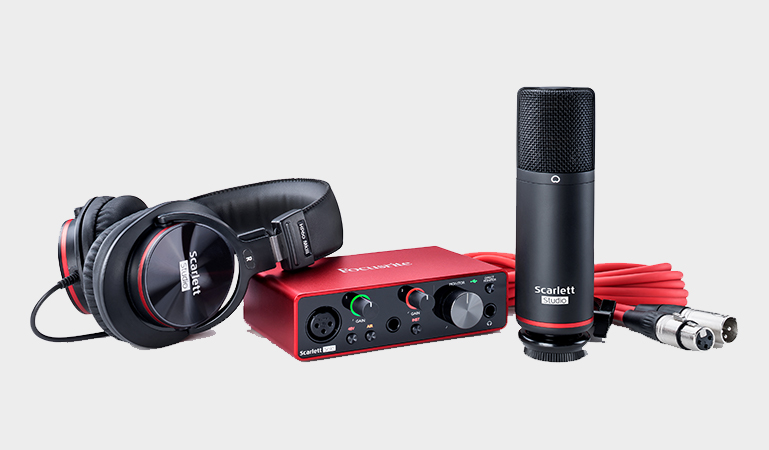
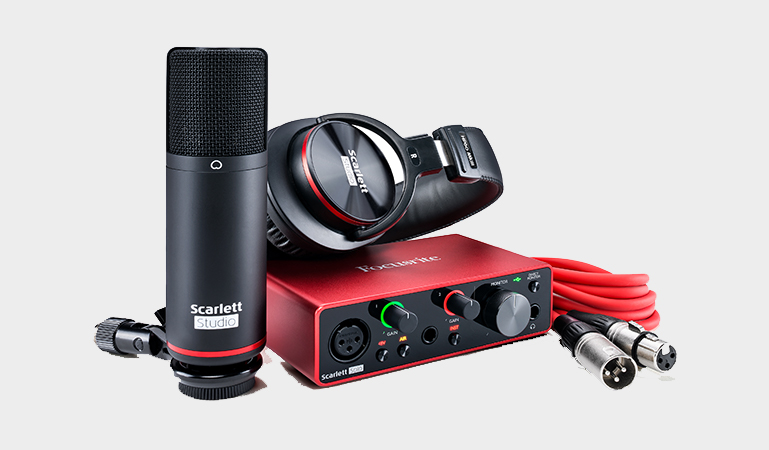
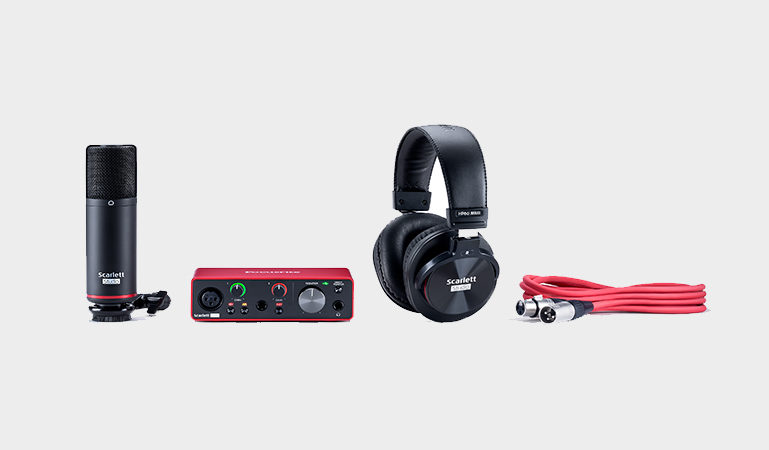
Think of the Scarlett Solo Studio 3rd Gen bundle as the perfect XLR microphone starter kit for under $300. The bundle includes Scarlett 2i2 3rd Gen Interface, a CM25 MkIII condenser microphone, HP60 MkIII closed-back headphones, one XLR cable, and a Type-C to Type-A USB cable to connect it to your PC. Everything you need to start podcasting or streaming.
XLR mics are known for their sound quality but require a USB interface like the Solo Studio, which could be a bit pricey. The $280 is an incredibly great price for all of that.
Focusrite isn't some recording nobody, either. It's a well-respected brand in professional audio with a legacy of quality products. From the products I've experienced in the past, I can see why: they're simple to operate yet technically effective for high-grade audio production.
That still holds true for the 3rd generation 2i2 included in the Studio bundle, which now runs entirely on a single USB Type-C to Type-A cable, even power. Its interface is brighter, cleaner, and more easily navigated than previous models.
As much a great condenser microphone as you could want from a setup at this price.
The 2i2 is a twin-preamp design, meaning you can run two microphones through this single interface for an easy podcast setup. Each input offers individual gain control, which is handy if you have a loud friend on the other end of the mic, but also great if you want to hook up an instrument on one input and record your silky voice box on the other. There's an INST switch for each input, which tweaks a couple of key specs for use with instruments, though what might be of greater interest to streamers and podcasters is the AIR switch.
The AIR switch, once enabled, bolsters the high frequencies by recreating the ISA 110 mic preamp found on the Focusrite Studio Console. That might not mean much to you, but the end result is it helps your voice pop just that little bit more. I also find it helps with clarity in the final recording.
Regarding microphone quality, the CM25 MkIII is as much a great condenser microphone as you could want from a setup at this price. It's functional and straightforward, and its all-metal construction gives me a lot of faith in its longevity. The tone is balanced and crisp, though you will need to be closer to the mic than you might otherwise with some popular USB microphones to get the tone you're looking for. That might suit you well if you're competing with ambient noise, though you might have to boost the gain a little higher than you'd like if you need to keep the mic further away from your face.
The 2i2's twin-preamp design lets you run two microphones through a single interface. This has always been a pain point for anyone who tried to plug more than one USB mic into a PC. That value alone is worth the price of admission, but there's a lot more to the 2i2 that we love.
Read our full Focusrite Scarlett 2i2 Studio Bundle review.
Best microphone FAQ
What is a polar pattern and which do I need for gaming?
A polar pattern determines how much and from which direction an audio signal will be picked up by a microphone. For gaming, you'll mostly want a pattern that picks up sound directly in front of the microphone (you) and not much else from anywhere else (the environment).
These are the most common polar patterns:
Cardioid: Records in front of the microphone. Perfect for voice-over, vocals, and streaming.
Bidirectional: Captures audio in front of and behind the mic. Ideal for one-on-one interviews.
Omnidirectional: Picks up sound from every direction. Perfect for round-table interviews, but not so much for gaming or streaming.
Stereo: Perfect for ASMR recordings. YouTube 'ASMR' if you want the best example because I couldn't do it just justice.
Do I need a microphone boom arm, shock mount, or pop filter?
Everyone’s desk and setup requirements are different, so a mic must perform well under a handful of different scenarios. Suppose a microphone sounds better than all the rest combined but only when it’s on a suspended mic stand with a shock mount positioned precisely six inches away from your mouth. In that case, it’s not necessarily a reliable option to recommend.
Saying that, however, there are some valuable bits you might want to pick up if you're looking to clear away clutter or build a more professional setup.
A boom arm certainly helps achieve both of those things. These almost always clip onto the side of your desk and are super handy to keep your mic close to hand while off your desk, saving precious real estate.
While a pop filter will help reduce plosives, the sound of air escaping violently from your mouth and towards the mic, from making their way over to airwaves to your listeners' unfortunate ear holes. It'll also stop your microphone from getting grubby when you're up-close and sounding sibilants.
A shock mount is perhaps the least necessary of the lot, at least for gaming. These prevent vibrations from traveling through your microphone stand or boom arm and into the microphone, which can come through as rustle, thuds, or otherwise unwanted noise. Certainly a must-have for music studios, unless you are one to slam your way through a match of Apex Legends, you might be okay without.
What's is a good sample and bit rate for a microphone?
Sample rate is the number of samples of audio recorded every second. 48kHz is the most common sample rate you'll see on many microphones, and you shouldn't be any lower than that.
Bit rate is the speed at which a digital and audio file gets encoded. Without trekking too much into audiophile territory, 16 bit and above is considered a good bit rate.
What connector do I need? XLR or USB?
USB microphones are among the most prevalent for gaming and streaming fare, but you'll sometimes see the more widely used professional connection standard, XLR, make its way into high-end units. Hybrid USB/XLR can offer you the best of both worlds but tend to be more expensive.
USB is the simpler of the two, and if you're looking for plug-and-play ease, then it's your best bet. However, that simplicity comes at a cost. It's difficult to record more than one USB microphone simultaneously, and monitoring and adjusting the mix will be done digitally.
With the added complexity of XLR comes a great deal of flexibility that you otherwise wouldn't be able to access without even more complex digital mixing software on a USB mic. You can mix, adjust, and monitor an XLR mic before it ever touches your PC, and that's a massive boon if you're looking for a more complex setup.
The downside to XLR is that they will require additional equipment to connect to your PC. It is nothing wild, just something to interface between the mic and PC, such as the many devices by that name, which often comes with mixing functionality built-in.
How much should I spend on a microphone?
And as PC gamers, we will, of course, always try to get the best we can for less. It’s easy to get lost in the deep dark woods that are the world of audio and even easier to spend a ludicrous amount of time and money chasing the best possible setup. But we don’t need studio-ready equipment, so the price is essential when looking at how good a particular mic is.
Think about your use case; if you're only using a microphone to chat with your teammates, chances are, you don't need a microphone with half a dozen polar patterns and have a podcast studio level of quality. Don't spend money on features you don't need or use. Some $50 or fewer microphones are more than adequate and great for gaming. We picked out the best budget microphones that we have tested this year if you need some guidance.

Post a Comment